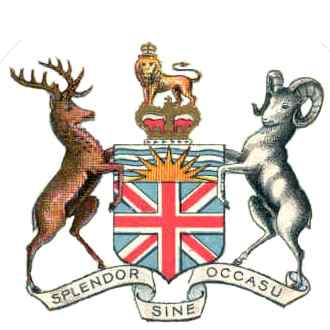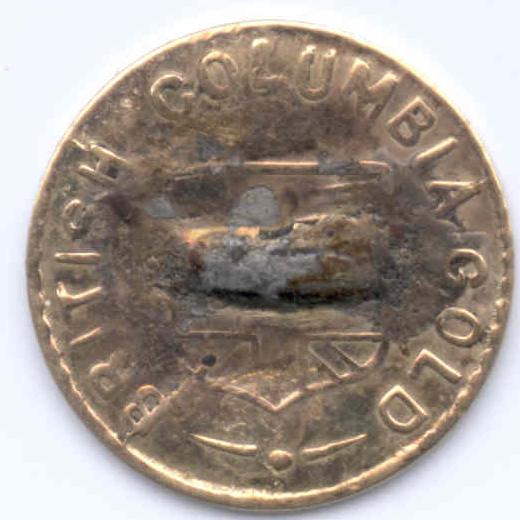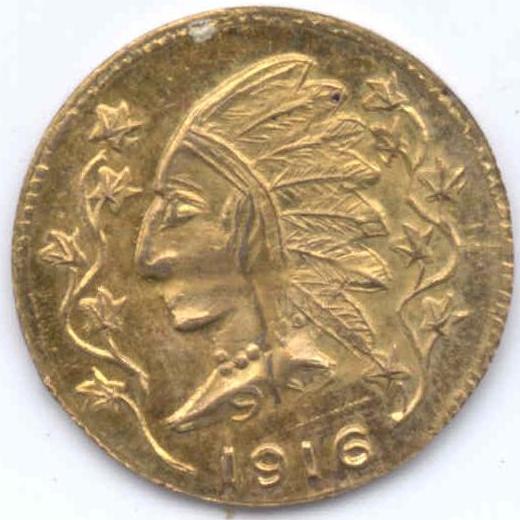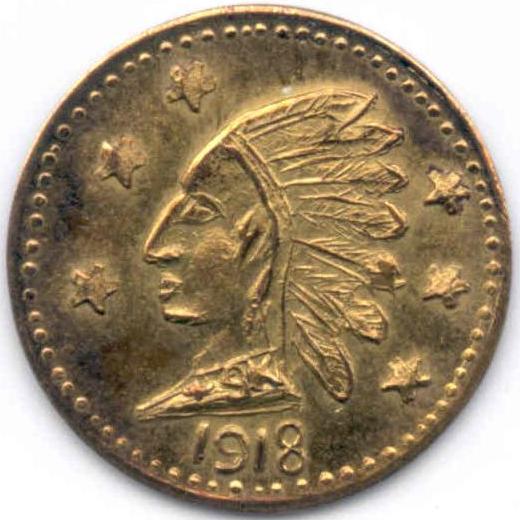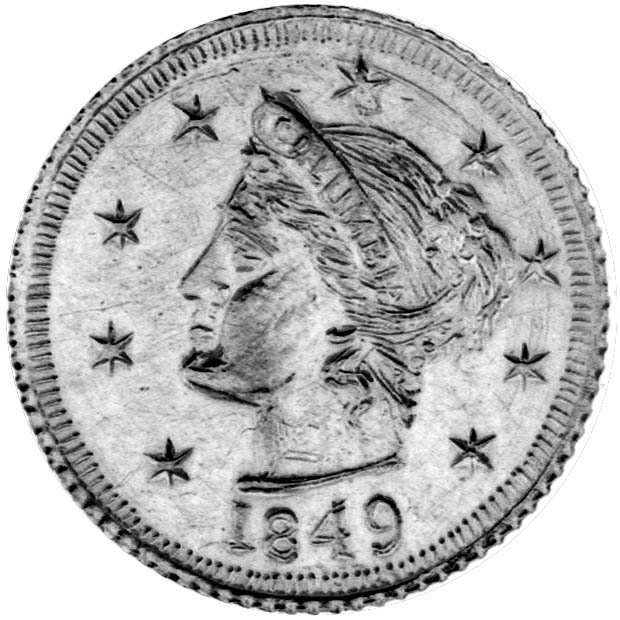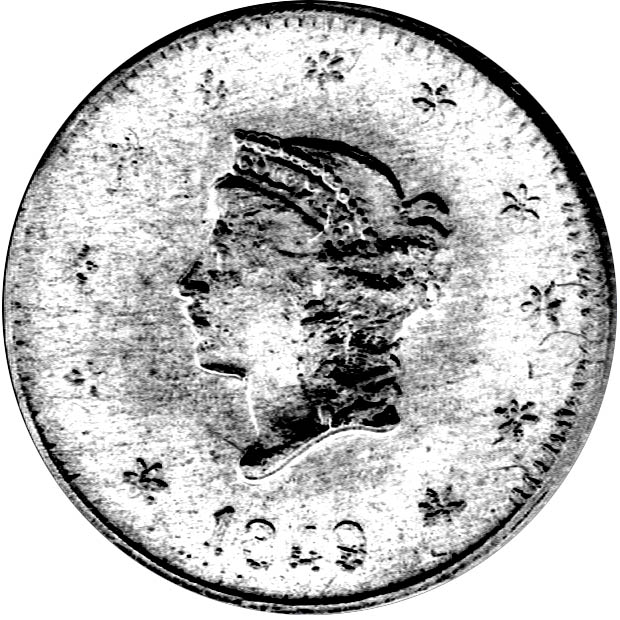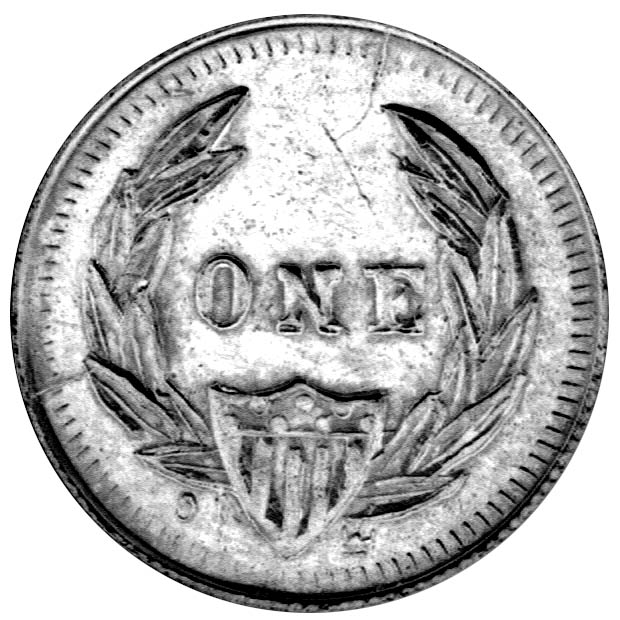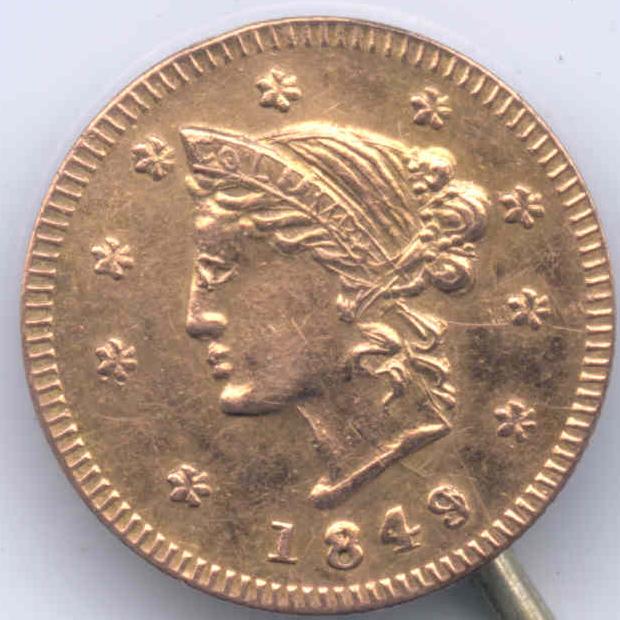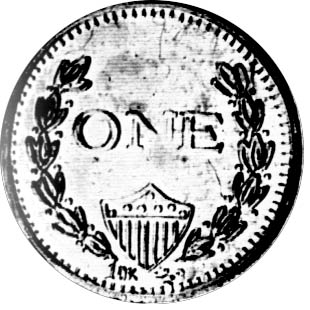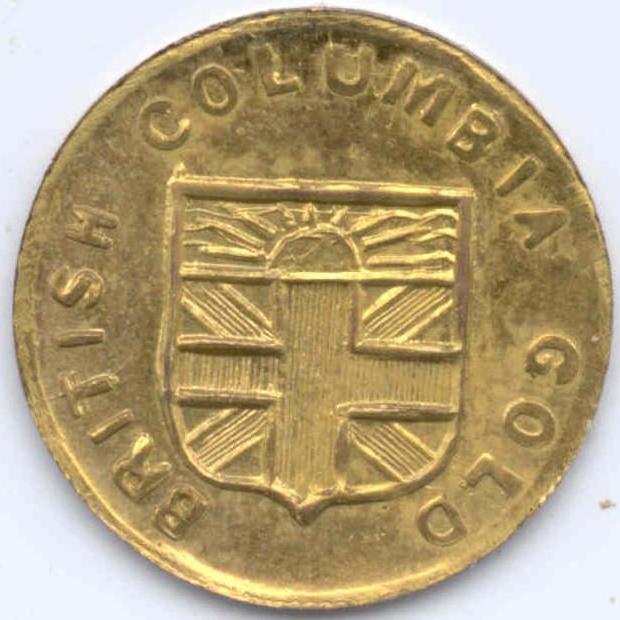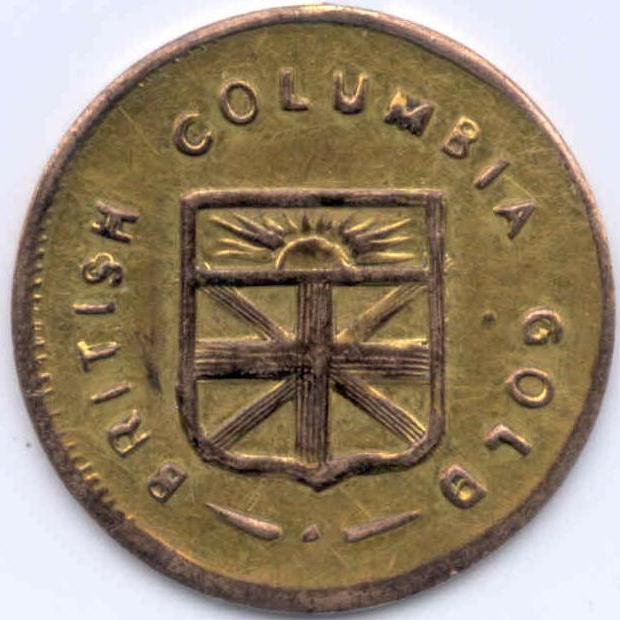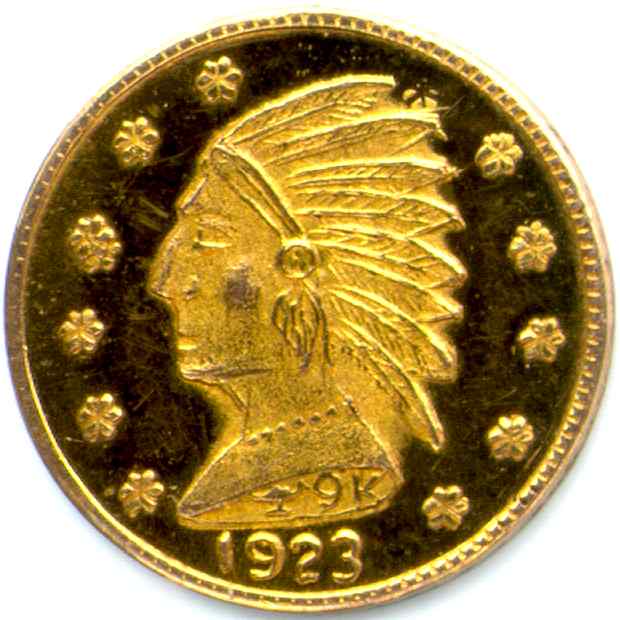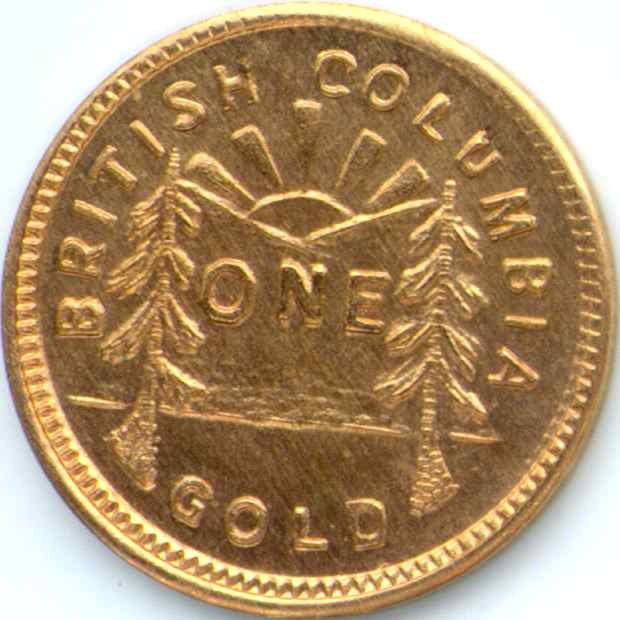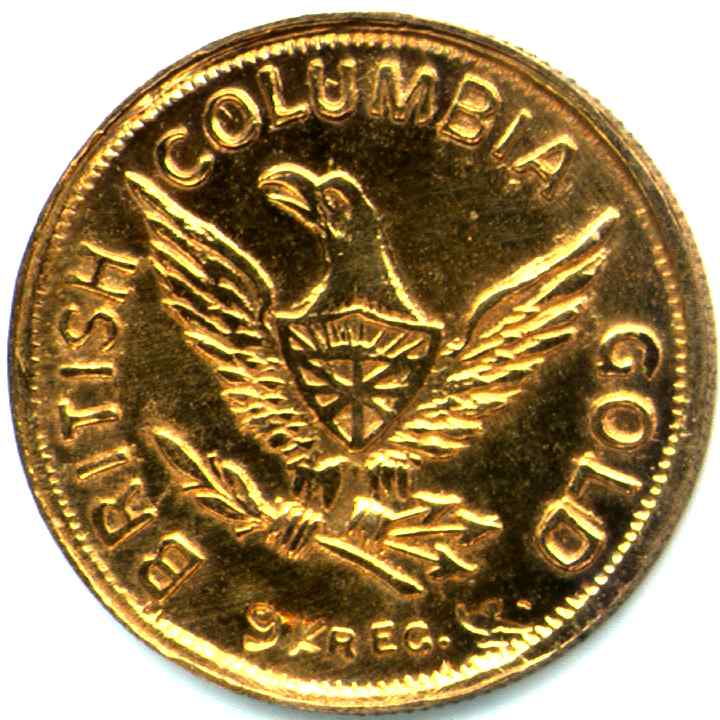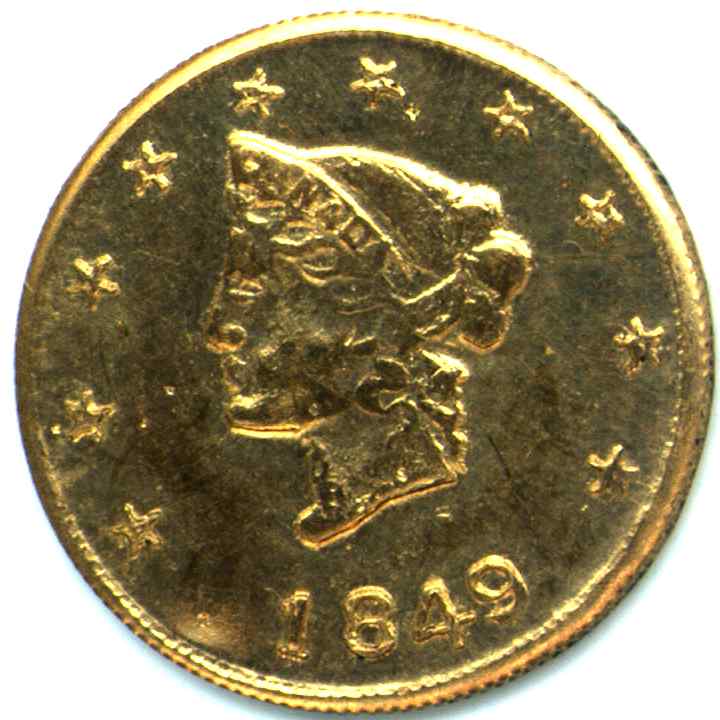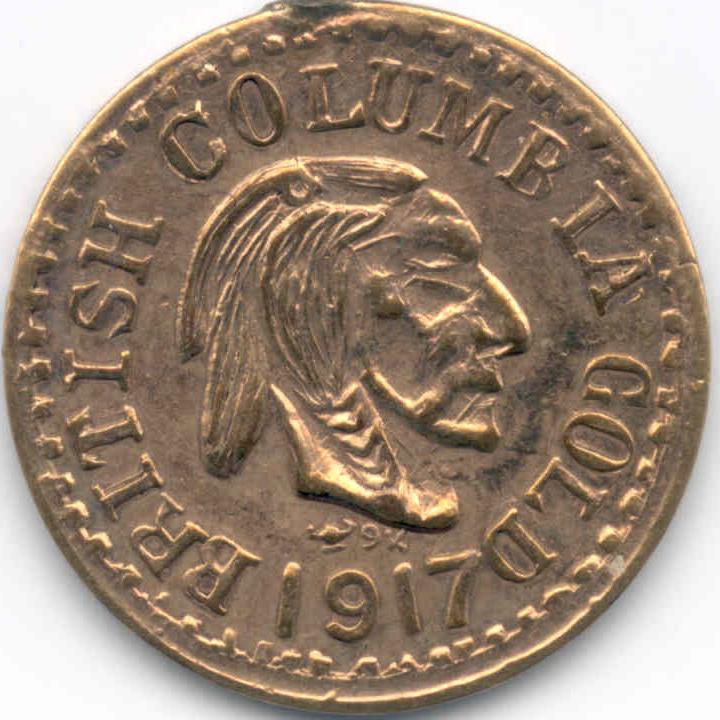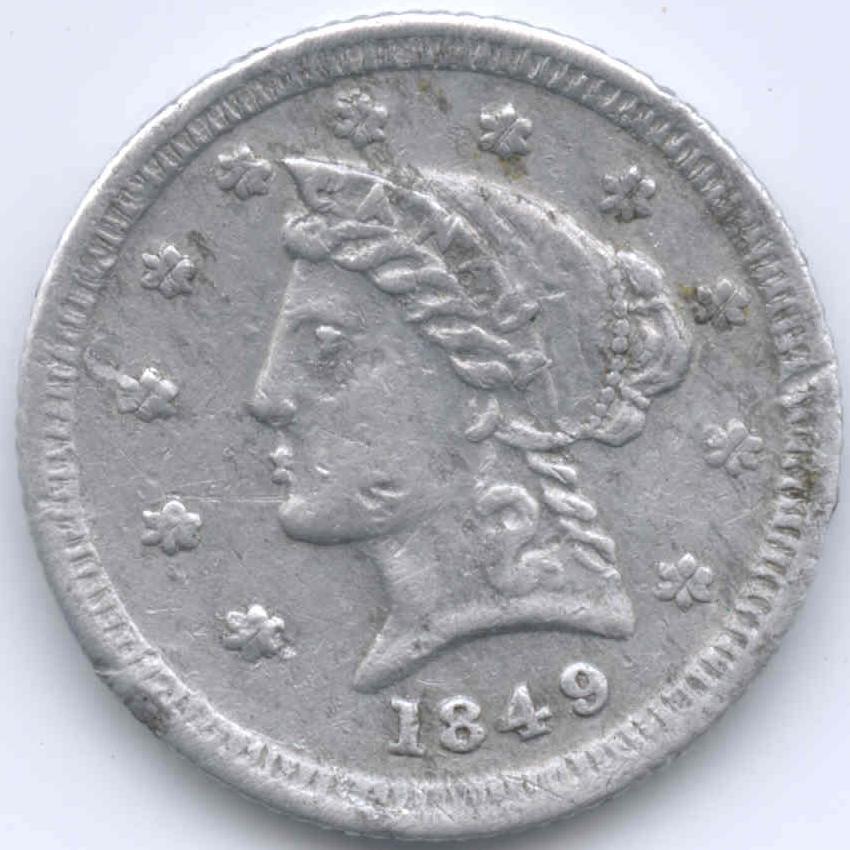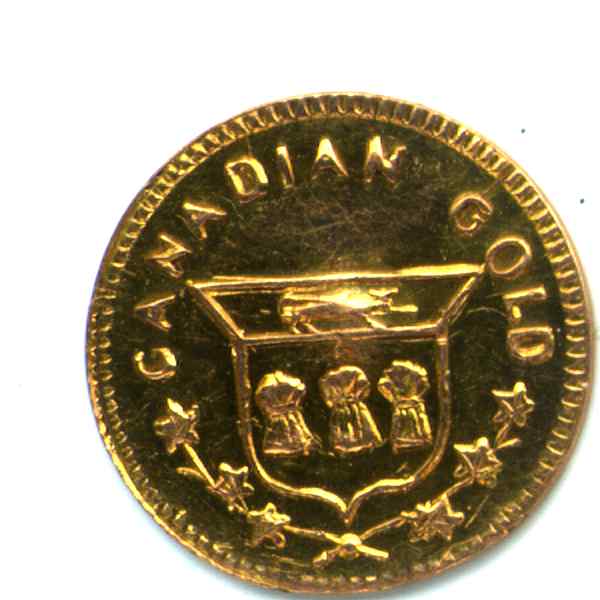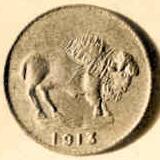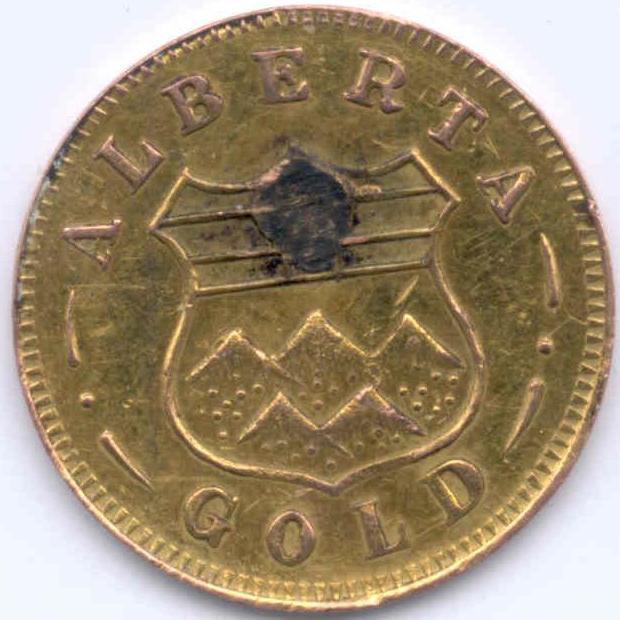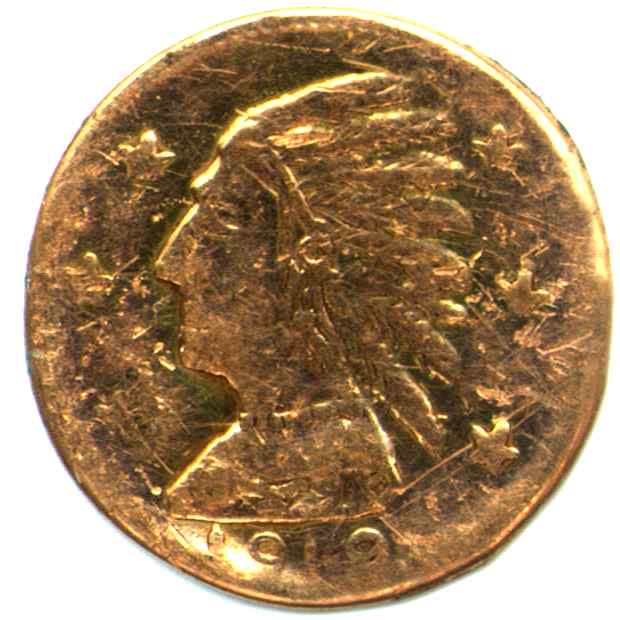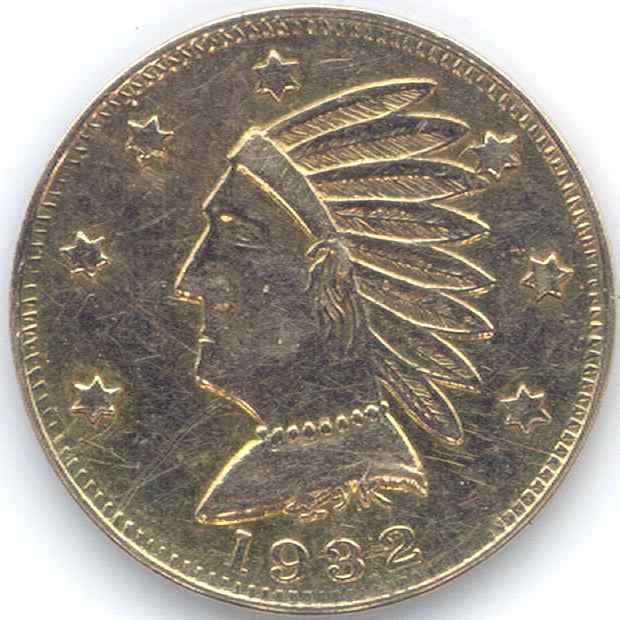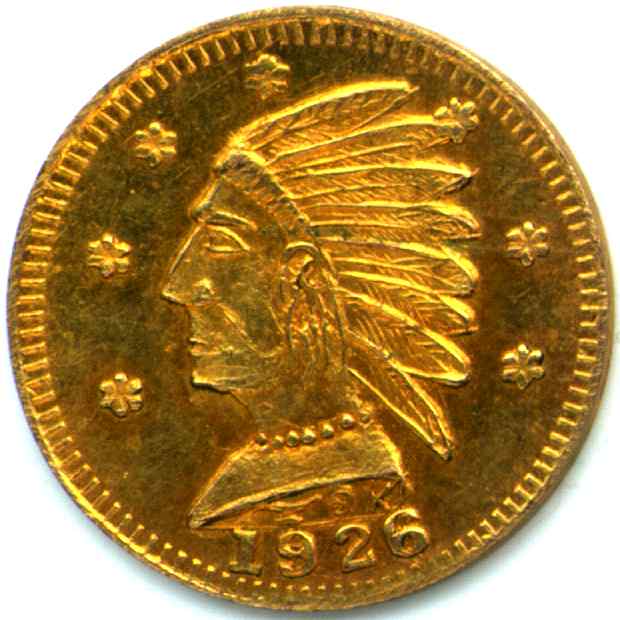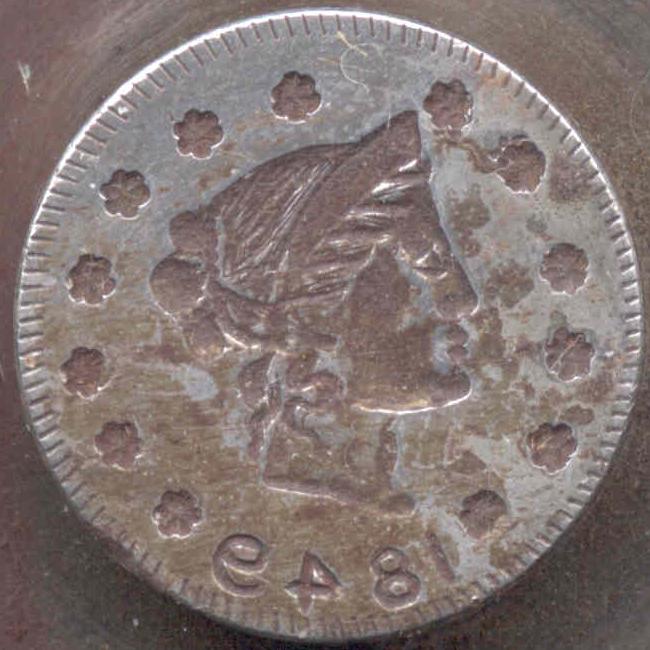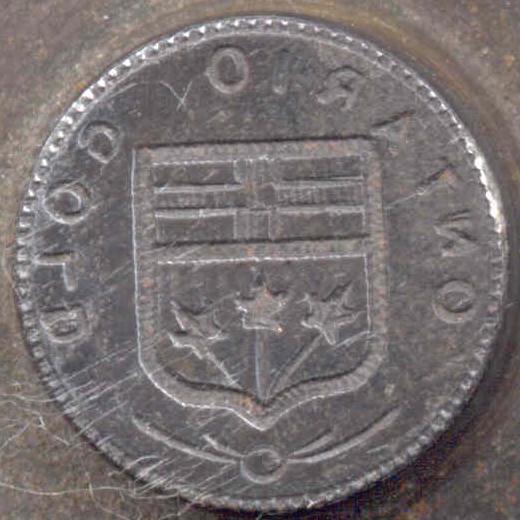CANADIAN GOLD JEWELLERS PIECES
by Ronald Greene (copyright 1990, 1992)
(All Rights Reserved)
Updated by Ronald Greene and Mike Locke, 2001.
Preface
This article started out to be a listing of the gold souvenirs or jewellers pieces that could be
grouped as "B.C. Gold" but as we gathered all the information, organized and reviewed it in
preparation to start writing the article we realized that we had to treat other pieces in the
same article because they were intrinsically related. And so we added other pieces known to
have been made in B.C. even though they may purport to be "Ontario Gold", or "Alberta Gold" or
what-have-you. Then we discussed the matter with several people who urged us to expand
the coverage to all of Canada. At first we hesitated because we had done little research
outside of B.C. items, but soon found that there were only two pieces known to have
been made outside of B.C. which made extension both easy and comprehensive.
I must thank Jay Roe with whom I have carried on correspondence over a dozen years.
John Cheramy and Leslie C. Hill have both contributed much to this article, as have Alan Trammel
and Nick Gerbinski. But perhaps most of all I must thank Robert S. "Bob" Jacoby
[pronouced Ja-koby] who has repeatedly added more information to what I previously
had. Before we look at the pieces themselves we should look at the one firm that
has produced more of the British Columbia jewellers pieces than all the other firms combined.
Historical Background
Jacoby Bros. Ltd., Manufacturing Jewelers
The firm of Jacoby Bros. Ltd., Manufacturing Jewelers was founded by Alfred James Jacoby,
better known as "Dick" Jacoby in 1909. The family headed by father James J.,
had come from Altona, Germany to Tacoma, Washington in 1892. James J. had six children,
four sons; Alfred (Dick), Martin, Sigfried (Sig), Henry and two daughters, Amalie and Henrietta.
In Tacoma James J. went into the dry goods business and became an American citizen.
In 1900, at age 14, Dick Jacoby started work with Mayer Bros. in Seattle where he learned
the manufacturing jewellery trade. In 1905 he moved to Vancouver, B.C. where he started to work
for Geo. E. Trorey, manufacturing and retail jewellers. Trorey sold out in 1907 to the
Henry Birks & Sons chain but continued to manage the store for the new owners. By 1908
Jacoby had become Trorey's head jeweller. That year he was offered, and accepted, a job
to manage a jeweller's factory in Nanaimo, [on Vancouver Island, about 30 miles due west
of Vancouver] at a 50% increase in pay. In less than a year the factory was closed and
Jacoby bought the equipment and returned to Vancouver where he set up in business in
October 1909 with $500.00 in capital.

|
Business grew quickly so that by 1910 there were 30 employees. All three brothers were
working with Dick before 1912. Martin became the die cutter and did all the firm's work
until he left in 1926 to start his own business, Pacific Gold. As we will see below,
Martin's departure was to have a great impact on the jeweller's pieces.
Dick Jacoby did not marry until he was 38 years of age and consequently he started a family
rather late in life. He had two sons, Alfred (Al) and Bob. Dick suffered a stroke in 1947 and
was not able to work for the last ten years of his life. Bob entered the business after his father's
illness, leaving school to do so in 1948. Al had worked for the company in 1945 but left for
several years and returned about 1949. For many years Al was the outside salesman and Bob was the
inside man--he ran the factory. Jacoby Bros Ltd. always did most of their work in gold and
only a very small portion in silver. In 1982, during a period of recession, the firm's
major customer, a national department store, Hudson's Bay Company, centralized its
purchasing in Toronto and the firm lost a great deal of business. The ensuing financial problems
led to a dissolution of the firm in 1985 with the final outcome that Bob purchased the assets
of the firm and carried on alone as Jacoby Jewellers Limited at the same location, but in a
much reduced manner. Jacoby Bros used the "Aladdin" brand name and the trade mark was
a small genie's lamp. Jacoby Jewellers now owns these. In 1994 Jacoby Jewellers closed
their factory and now are selling other's products.
Bob Jacoby put us in touch with a former employee, Don Plummer1.
He had entered into an
apprenticeship with the firm in 1946 following his war service and had struck many of these
pieces on their big old drop hammer. His description of the operation may be in order here.
The firm actually had two drop hammers. The smaller one (shown at left) was the first, but
by 1946 was no longer in use and after 1953 served as a flower pot holder and ornament in
their reception area. Although
attractive it was pretty puny, having a head of only about seventy pounds and a drop of about
three feet. But the other drop hammer was much larger and had a motorized drum that was always
revolving at the top of the machine. There were two grooves on the drum. A rope ran from the
hammer head over the drum and down again. The rope was coated with bees-wax. When the workman
wanted to raise the hammer he pulled on the end of the rope with his right hand
which caused the drum to grip the rope in the groove and pull the hammer up. When the hammer
head had passed the catch, with his left hand the workman would lock the catch and release the rope.
The hammer would fall back onto the catch, ready to strike. At this time the workman could place
the blank on the bottom die, inside the retaining ring, then release the hammer by lifting it
slightly (right hand) and releasing the catch lock with his left. When the rope was released
the hammer fell. The worker had to catch the hammer on the bounce, before it struck a second
time, and then by pulling on the rope raise the hammer again. The hammer, an antique even
then, was very labour intensive but quite safe because the workman always had to have both
hands safely working the catch lock and rope to cause the hammer head to drop. Mr. Plummer
left Jacoby in 1950 and joined another former Jacoby apprentice to form JEDCO, an Edmonton
manufacturing jeweller. He is now retired and living in B.C.
|
Pressed Metal Products took over the Jacoby Bros large drop hammer when the latter company
moved from Hamilton Street to West Pender Street in 1953 and an agreement was made that
PMP would do all the stamping work for Jacoby. Frank Sarson had developed a collar to
to apply a milled edge on the tokens. This collar worked moderately well but the quality
of milling varies from point to point on the pieces. The agreement with PMP died when
Alan Trammell took over PMP in 1976 for he raised the short-run prices significantly, beyond
the value that the Jacobys felt they could obtain for their product. The author also suffered
similarly when the price for his metallic business cards was quadrupled. Unfortunately the standard agreement
was that the dies remained in the possession of PMP even though the customer had paid for
the dies, and so for a period of almost five years from 1976 until 1981 when they made
other arrangements the Jacobys did not produce any of their souvenir gold.
The last Jacoby production was from dies cut in 1981 by Stjepan Pticek who operated as
Empress Engraving & Mint Company in the Vancouver suburb of Coquitlam.
If we look at small California gold coins and tokens we note that the earliest pieces
appear to have circulated as there was a great dearth of small change.
Breen2 says that this period lasted only
until 1856. In later years the pieces were produced solely as souvenirs. The same does not
hold true for British Columbia gold tokens. From the very beginning, the pieces covered in this article
were made only as souvenirs or intended for incorporation into jewellery--tie tacks, ear-rings,
brooches, hatpins, scarfpins, etc. They were never used as a circulating medium. They
were much cheaper to use than the U.S. Gold Dollar and Newfoundland Gold 2 Dollar that had no
Canadian equivalents and did not circulated in Canada. Jacoby Bros advertised their
pieces as "B.C. Gold Souvenirs".
In view of Jacoby's connection with the Seattle firm of Mayer Bros and the time of his
apprenticeship it is probable that he and his brothers, particularly Martin, were familiar
with the various tokens produced by M Hart of San Francisco and sold at the Alaska Yukon
Pacific Exposition in Seattle in 1909. These included the Alaska Pinch series dated 1897
through 1902 and the DWT series of the 1909 Alaska Yukon Pacific Exposition. As we have
noted, Martin left the firm in 1926 to pursue separate interests. Is it a mere coincidence
that after a long British Columbia Gold series in which almost every year from 1912 to 1926 is represented, excepting
only 1925, that the date 1849A appears and remains unchanged to this day? We might also ask why the date of 1849, which has no particular
significance to British Columbia, but Bob Jacoby's answer to this is that his father
was an American citizen and 1849 was such an important date for the American west.
The use of such other symbols as an eagle, a plains Indian rather than a coast Indian, a Liberty
head, and a striped shield are also more clearly American than Canadian. Some of the pieces
strongly resemble the U.S. "Liberty" $2.50 and $5.00 coins. Until recently it had been a
reasonable assumption that the pieces dated 1912 through 1926 were originally produced in the
year so indicated. Any earlier dates are obviously not related to the date of manufacture.
Unfortunately the "Benny Lee" restrike have made any such assumption somewhat risky
[see "Benny Lee" notes below].
Some of Jacoby's pieces are marked "9K" which was the standard gold content used earlier.
About 1949 or 1950 the standard became "10K" but the dies weren't changed until new dies were
needed. Starting in the 1950s a proprietary gold alloy for the souvenir pieces was purchased
from Johnson Matthey Mallory. It was a soft alloy suitable for striking. Prior to that time,
the gold alloy was mixed by Jacoby's from scrap gold. As a result, the content of the alloy
of the earlier tokens is variable.
Jacoby Bros. obviously had more success with their souvenir gold than the other manufacturers
and they promoted the product. The montage below illustrates the literature distributed by
Jacoby in the 1918 time frame. From top to bottom are: the original photograph
for the top illustration of the price list (the picture on the price list does not reproduce
well), pricing and a few mounting fees from the November 6, 1918 price list, the bottom illustration
from the 1918 price list, the front cover of the 1918 price list (left), and a promotional
photograph of a "7 Coin Fob, with double strand, with swivel $3.50, coins extra"
as made by Jacoby. The 4 Alberta GOLD varieties shown at the top are currently unknown in
any collection. The Coin Fob is apparently constructed from #150 and #390.

|

|
Other trade prices for the current production were:
in 1965 1/4, 1 and 2 $ 3.70 per set
in 1985 1/4 12.60 each
1 18.25 each
There were several other manufacturers to whom we can attribute jeweller's pieces and these are:
1. Trayling and Waters. This firm was started in 1919 by Alex J. Waters. In the following
year Waters took in Albert Joseph Trayling as a partner, but Trayling's health was not good so
he retired and sold his interest to Waters in 1924. The firm never had a great interest in
medallic work but in the 1920's was responsible for a great number of medals, particularly
for lower mainland sporting groups. Their trade mark is +W+ (plus sign, W, plus sign).
Their only jeweller's pieces are dated 1792, an allusion to the date that Capt. George
Vancouver arrived at this coast to survey. Trayling & Waters were closed by the
receivers on November 2, 1987.
2. Henry Birks & Sons Ltd. (Birks). According to a company publication entitled, "A
History of the House of Birks," Henry Birks (of Montreal) entered the firm of Savage & Lyman in
1857. He became a partner in 1868, but the firm went into liquidation in 1877 and he then opened
on his own, as Henry Birks & Co. in 1879. The name became Henry Birks & Sons Ltd. in 1893.
The firm has acquired or amalgamated with many other important firms over the years, including
such well known medal-striking firms as Ryrie Bros, Ellis, and Dingwall. There have been many
name changes which reflected the corporate structure, but today the firm, once again known
as Henry Birks & Sons, Ltd, is the pre-eminent jewellery company in Canada. In the early
1990's the frim ran into problems and was acquired by an Italian firm, Borgosesia SpA,
which continues to trade using the Birks name.
There is one Birks jeweller's piece known and it bears the date 1879, which apparently refers
to the year in which the company was founded. The time frame during which these were struck
is not known, but it was struck prior to 1958. It appears that by 1958 Pressed Metal
Products was also doing Birks' stamping work, since by that time the dies were in the
possession of PMP.
About 1958 a then-active member of the Victoria Numismatic Society of Victoria, B.C.
made some arrangements for various medals to be restruck from Birks dies, including the
1879 jeweller's piece. A couple of these restrikes were given out at Society banquets.
Other medals were restruck and sold at nominal prices. However, the 1879 B.C. gold
jeweller's piece led him to considerable difficulty. Advertised in the Canadian
Numismatic Journal for September 1958, p 281 Vol II as item 23 of a fixed price list
was "B.C. Gold $ Size 1871 Unc. [$} 6.00" Subsequent ads corrected the date
to 1879. The story he told the author in 1980 and confirmed by Leslie Hill who obtained
his information from Frank H. Sarson was that the original die was not suitable for use and
Sarson made a copy, which was used to make the "restrikes". Unfortunately for the fellow
he did not come out and say that he had had the pieces struck--the author recalls being
told at the time words to the effect that he had acquired a small quantity of these.
For the price asked one didn't expect a great rarity, but one of his customers was a
clerk in the Attorney-General's department who pursued the matter until charges were
laid, which subsequently led to a conviction for fraud
Reports of the trial3 indicate that he had purchased some
52 pieces, all but one of which were sold either in 1958 or 1959.
3. Pressed Metal Products. Frank Sarson had been an employee of D.R. Dingwall of Winnipeg
when he formed a short lived partnership with Walter Allbutt in about 1914. The firm of
Sarson and Allbutt was only listed in the 1914 Winnipeg city directory. He returned to
work as a diesinker for Dingwall until 1922, but was not listed after that. According
to Leslie C. Hill4 the firm was started in 1929 at 446 Railway Street in Vancouver by
Colin MacDonald and Frank Sarson. In 1931 Sarson replaced MacDonald as the President, and
in 1945 was replaced in turn by his son, Frank H. Sarson. Frank H. sold out in 1976 to
Alan Trammell and retired. He passed away in 1985. The firm is still in operation. As
mentioned above the firm made an arrangement to do the stamping work for Jacoby Bros in 1953. A
similar agreement was apparently made with Trayling & Waters for PMP holds the Trayling & Waters
dies for the 1792 dated pieces.
The mint mark of Pressed Metal Products is  , a backward P, M, P. This is found only
on three souvenir pieces made for the Prince Rupert firm of Manson's Jeweller's Ltd. The
founder of this company, Al Manson, is both a good customer of the Jacoby's and distantly
related to them--Martin Jacoby married a Manson. When the Jacoby's could not reorder their
jeweller's pieces from PMP they gave permission [c. 1980] for Manson to have pieces struck
by PMP as he needed them. By 1986 PMP had produced new dies for Manson. When the author
visited the Prince Rupert firm on April 2, 1990 only the two larger pieces were still
available, so at least one unrecorded smaller piece exists.
, a backward P, M, P. This is found only
on three souvenir pieces made for the Prince Rupert firm of Manson's Jeweller's Ltd. The
founder of this company, Al Manson, is both a good customer of the Jacoby's and distantly
related to them--Martin Jacoby married a Manson. When the Jacoby's could not reorder their
jeweller's pieces from PMP they gave permission [c. 1980] for Manson to have pieces struck
by PMP as he needed them. By 1986 PMP had produced new dies for Manson. When the author
visited the Prince Rupert firm on April 2, 1990 only the two larger pieces were still
available, so at least one unrecorded smaller piece exists.
PMP also produced the "Benny Lee" items. About 1985 Benny Lee, a Vancouver coin dealer now
deceased, offered a group of nine pieces to Jay Roe, who bought them. Jay had some doubts
about the pieces and mentioned them to us when we met at his table at the 1986 ANA in Milwaukee.
Later that day we came across three more pieces at the table of a Washington state dealer, who told
us that he had obtained them from Benny Lee. One of the pieces appeared to be authentic in every respect
but two of the pieces were off-colour, much whiter than those usually encountered, as if the alloy
contained more silver. These were similar to the pieces acquired by Jay Roe. A little later we
were in Vancouver and tried to obtain some information from Benny Lee, who denied any knowledge of
such pieces. In 1987 another U.S. dealer advised me that he had bought 30 pieces about two years
before from the same Vancouver source, i.e. Benny Lee. He states, "Unfortunately I found out too
late about their recent status although I was assured they were from an 'old' estate." In early
1987 when we were ordering a wedding medal for our older daughter's wedding Alan Trammell
told us that he had made some pieces for Benny Lee. In our endeavour of putting this article
together we approached Alan Trammell and, admitting that we were presumptuous at the least,
we asked for his cooperation, which was freely offered. A visit was laid on and upon our arrival
[May 8, 1990] there was a box set out containing over forty dies for our perusal [listed in
the appendix]. Some discussion ensued, with regard to the "Benny Lee" order. Benny Lee
was a fairly regular PMP customer. He had been instrumental through "Limited Editions Mint"
in producing a set of Chinese Dynasty trade dollars, and in 1977 had ordered a medal for
the 25th Silver Jubilee of Queen Elizabeth.
Alan, and his shop foreman remembered an order that originated as an enquiry along the lines
of, 'I've got some old gold, have you any old dies that we could have some souvenirs struck
up from?' Having a stock of maybe some 15,000 dies on hand, and at least forty old souvenir
dies they certainly had. They made up an order, apparently mixing and matching the dies without
any concern as to the origin of the dies. Since most of the dies, other than some of Jacoby's
which have the lamp trade mark, have no markings on them it is easy to see how the
Jacoby-Trayling & Waters mules arose. It was also remembered that Benny Lee had brought in his
own gold and wanted it made to the old 9K standard. The foreman thought that they had made up
about 100 pieces, and when I was able to estimate the date Alan looked up his records and found
an invoice marked 9K, dated August 13, 1985 for $ 624.00. Alan thought this would have been
104 pieces at $ 6.00 each. Looking through his records from 1984 through 1986 he found only one
other order, June 13, 1985, marked 10K which he thought was for another lot of the 10K 1977
Queen Elizabeth medals. It was not until Jerome Remick, who has promoted Pressed Metal Products
through his Association of Personal Medal Issuers, mentioned the ill effect of restrikes on the
numismatic market--we think with reference to some restruck trade dollars--that Alan realized
that he should not be doing this. His co-operation for this endeavour was very considerable,
and very much appreciated. When several dies that we know were used were not visible, the Facing
Indian, and the Birks dies, the foreman went out and took another look without avail.
Benny Lee told Jay Roe that the nine pieces represented all the types, but there are two more
pieces that may be, for the want of a better word, questionable. We believe that there were six
obverse dies involved, five of which were combined with two reverse dies, and the sixth is
known only with one reverse die. Jay Roe, who has seen more of these pieces than the author,
believes that the surface of the Benny Lee restrikes is rougher than on the earlier authentic
pieces, which would be reasonable when it is realized that the dies may have been sitting
for up to seventy years unused and rusting. See the appendix for the die combinations which
have been observed.
4. Regency Coin & Stamp Co. Ltd. This was a Winnipeg firm operated by Somer James and
Nick Gerbinski. In 1961 they decided that they wanted to produce a souvenir piece.
Nick Gerbinski5 told the author that they checked
with their lawyer and the R.C.M.P., explaining
the nature of the piece and were told that there was no problem with their proposed design.
They wanted a Buffalo, the Manitoba symbol. The denominations and the date were picked out of
the blue. They had the dies engraved by a local manufacturing jeweller, S. (Saul?) Trepel,
whose initials appear on the pieces. Nick wasn't certain, but the "W" that also appears
may stand for Winnipeg. About 200 of each denomination was struck and advertised for
sale, [i.e. CN Journal, Jan 1962, p. 60]. The ad mentioned 18K but some of the pieces
were struck in a higher karat, 22K. As the same dies were used only the colour and density
would show any difference. At the time that the charges were being laid in the Victoria case it
was realized that Regency was producing these pieces and so the R.C.M.P. seized the dies and some
sample pieces, giving receipts for the items. The seized items were never returned, but there
were no charges laid, presumably since Regency never hid the true nature of the pieces.
The Arms of British Columbia
The Arms of the province, designed by the Rev. Beanlands, were adopted in 1895. They consisted
of the shield supported by a Wapiti (Elk) stag at the left and a Big Horn Ram at the right.
The crest was a crowned lion standing on an Imperial crown and the motto below reads
"Splendor Sine Occasu" (splendor without diminishment). The College of Heralds refused to
accept the design for two reasons. Firstly, the shield had a setting sun on a wavy background
(for the Pacific Ocean) above the Union jack which was improper as nothing should go above
the Union Jack. And secondly the College objected to the crest which is a royal symbol and
thus should not have been used--although the Province had been using it as a badge for some
time, obviously without proper authority. On March 31, 1906 a grant of a shield and motto
was made, with the Union Jack placed above the sun and wavy background. An additional feature,
centred on the Union Jack was a small gold "antique" crown. The shield should be split
about evenly between the two design elements. Most of the souvenir pieces do not reflect
the correction of the shield. Throughout the variety descriptions that follow, the original
design by Rev. Beanlands is refered to as the "incorrect Arms" while the design granted in 1906
is refered to as the "correct Arms". The Province of British Columbia continued to use the
corrected shield with the incorrect crest until 1987 when new arms, slight modified,
were granted.
The Union Flag, more commonly called the Union Jack, consists of three crosses superimposed.
The front cross, with arms that are horizontal and vertical is the Cross of St. George
(for England). Its colours are red on a white background. The Cross of St. Andrews
(for Scotland) is like an "X" with diagonal arms, white on a blue background. The Cross
of St. Patrick (for Ireland) is also an "X" and is red on white. It is on top of the Cross
of St. Andrews and the two crosses appear as one.
The illustrations above show, from left to right:
The correct and current Arms of British Columbia, as adopted in 1906
The incorrect Arms of British Columbia, as rendered in 1898
The Pieces
In the author's experience a very high percentage of the pieces encountered show signs
of having been made into brooches, earrings, tie-pins, bracelets, or some other form
of jewellery. Solder marks are almost the norm rather than the exception. While
Jacoby was located on West Pender (1953 to C. 1970) there was a coin dealer around the
corner, Nick Papafingos, who was a regular customer for the jewellers pieces and it is
probably through him that the majority of the 1849 dated pieces reached the numismatic
market. Two anecdotes came to Bob Jacoby following discussion about this article. One
was occasioned by a sale, about 1962, of a bunch of the souvenir pieces to a Seattle
dealer. The first order was picked up in Vancouver, but the second order was shipped
to Seattle and shortly thereafter Jacoby had a visit from two gentleman, one was a
Mountie (Royal Canadian Mounted Police) and the other was a U.S. Secret Service man
who asked [instructed?] Jacobys not to send these into the U.S. again since they were illegal
there. Another was a fellow who bought a bunch of the souvenirs and took them to China
immediately following World War II. The story may be apocryphal, but Bob was told that the
man tried to pass the pieces off as U.S. coins and was killed for his efforts.
There appears to have been little numismatic interest, past or present, in these pieces
in Canada. They occasionally show up on auction lists, but surprisingly appear more often
in the United States. As to rarity, we can only hazard a guess. Obviously "mint" records
are not available. However, Bob Jacoby remembers that in the 1950s, typical orders were
for 1000 large pieces, 500 smaller pieces and that multiple orders would have been received
per year. Since it is clear that the dies were used over a period of decades, it is
possible that the mintages of some varieties could have been in the tens of thousands.
The order size and rate declined dramatically in the later years, such that mintages as
small as a few hundred per variety are likely. Mintages of the pre-WWII Jacoby pieces
is unknown. Of course, mintage and the surviving population can be substantially
different. In some cases of the pieces not currently in production we have had only
one reference or one example available for study. In other cases two, three, or even five
pieces have been available. We have not recorded examples from some of the known dies, so
there must be unknown pieces lurking in jewellery boxes or button jars somewhere.
We expect that this article will uncover more varieties that we have not yet noted and
would invite correspondence.
One note, a major offering of these pieces appeared in the CNA 1990 sale. Unfortunately
while the first listing had been submitted to the publisher it had not yet been published.
Not able to find any information the author of the catalogue wrote some prime fiction about
the pieces. When we pointed out some of the errors, admittedly not too gently, he became
rather incensed and banned us from the sale. To our knowledge no retraction of any of the
erroneous or misleading statements in the catalogue was made during the sale.
Ronald Greene, P.O. Box 1351, Victoria, B.C., Canada V8W 2W7
Mike Locke, P.O. Box 2582, Santa Clara, Ca., U.S.A. 95055
lockem@calgoldcoin.com
http://www.calgoldcoin.com
The listing and plates.
The British Columbia pieces which form the majority of the pieces listed have been grouped into four
categories by increasing size, corresponding as closely as possible to the "denominations"
marked, i.e. 1/4, 1/2, One, and Two. Within each group the pieces are ranked by indicated date--not
the date of manufacture. The non-B.C. pieces follow the B.C. listings. The numbering
has been arranged so that later additions can be made to the list without the need to renumber
the series. We have been reluctant to list pieces that have not been reported even though the
dies exist. However, a group of tokens that are illustrated in Jacoby literature but that
are currently unknown have been listed and assigned Unk (unknown) numbers.
The illustrations have been taken from many sources. To the extent possible, they have been
adjusted to an equivalent resolution of 600dpi. All illustrations are placed above the descriptions.
In some cases, varieties are illustrated by utilizing pictures from other die pairings. The comments
in the description of all such illustrations note the source of the pictures. Such illustrations
help in the identification of the variety, but should never be used to qualify die states or similar
fine details.
There are a total of 118 varieties, plus the 4 "unknown" varieties in this listing.
Notes
A. The 1932 dated piece contradicts this sequence. We can conjecture
that the 1932 piece is a blundered die intended to be dated 1923, or that it was made in
1932 by Martin Jacoby as a favor to his family; however we do not know how this die
came to exist.
Reference
1. Don Plummer, conversation with author, May 8, 1990.
2. Breen and Gillio, California Pioneer Fractional Gold, Pacific Coast Galleries,
Santa Barbara, 1983.
3. Victoria Daily Times, Nov. 15, 1962
4. Hill, "Pressed Metal Products Ltd," CNRS Transactions, pp40-42 summer 1989
5. Nick Gerbinski, conversation with author, May 12, 1990.
A INITIAL LISTING OF THE JEWELLER'S PIECES (118 varieties)
BRITISH COLUMBIA GOLD
The rim treatment of each die is described as follows
bars Denticles, longer than wide and radial
plain Smooth. No denticles
A. 25 Cent Nominal 9-1/2 mm to 10 mm
10. 1849 25 cents Nominal
obv: U001, Liberty head facing left, seven six-pointed stars/1849
"9" of date has a curious flat middle bar. Rim: well formed bars
rev: U501, British Columbia Gold around the incorrect B.C. shield.
Vertical shading in the St. George cross, none in the other crosses.
Four sun-rays but no waves. Rim: bars, less well formed than U001
edge: milled
diameter: 9-3/4 mm
comment: nicely engraved, have two examples which Bob
Jacoby found when cleaning up an old desk. Roe No. 8
20. 1849 25 cents Nominal
obv: U002, Liberty head facing left, seven five-pointed stars/1849
"9K" on truncation. The star in front of the date has an arm
pointing at the date. (shallow engraving, deteriorating with
die stage) Rim: weak denticles in early die stages, fading out
to plain on later tokens.
rev: U502, 1/4 (horizontal line) surrounded by wreath, american
style shield (5 dots and 3 vertical bars) below, surface
very rough. Rim: weak cuts varying directions
Used on varieties 20, 30, 35, and 40
edge: milled
diameter: 9-1/2 mm
comment: this is quite crude and very similar to the
following pieces No. 30 and 40. Roe No. 3
Mike Locke collection.
30. 1849 25 cents Nominal
obv: U003, Liberty head facing left, seven five-pointed stars/1849
"9K" on truncation. The star in front of the date has an arm
pointing at the date. An incuse lamp cuts into the 9 of the
date (shallow engraving). Rim: plain
rev: U502, 1/4 (horizontal line) surrounded by wreath, american
style shield (5 dots and 3 vertical bars) below, surface
very rough. Rim: weak cuts varying directions
Used on varieties 20, 30, 35, and 40
comment: we are not certain whether the lamp was added
later or not. Mike Locke collection
35. 1849 25 cents Nominal
obv: U004, head is as # 30. but stars are located differently.
First star in front is opposite neck. The third, fourth and
fifth stars appear doubled. The field dips around most stars.
All stars are 5 pointed. Date is as # 20. No lamp.
rim: denticles are tapered.
rev: U502, 1/4 (horizontal line) surrounded by wreath, american
style shield (5 dots and 3 vertical bars) below, surface
very rough. Rim: weak cuts varying directions
Used on varieties 20, 30, 35, and 40
edge: good milling
diameter: 10 mm
comment: Reverse of #40 shown. Reverse is an earlier die state than #40.
40. 1849 25 cents Nominal
obv: Liberty head facing left, seven five-pointed stars/1849,
the arms of the star in front of date do not point at the date
(very shallow engraving) rim: plain. Die #1039
rev: U502, 1/4 (horizontal line) surrounded by wreath, american
style shield (5 dots and 3 vertical bars) below, surface
very rough. Rim: weak cuts varying directions
Used on varieties 20, 30, 35, and 40
edge: milled
diameter: 9-1/2 mm
comment: This is the piece being made in the mid 1960's
by Jacoby Bros. Reverse is a later die state than #35.
45. 1849 25 cents Nominal
obv: U073 Athenian helmeted head facing left, eight five-pointed
stars in front and seven behind/1849, rim: bars
rev: U564 1/4 surrounded by wreath, large american style shield
below, (13 dots, 5 bars), rim: bars
edge: milled
diameter: unknown mm
comment: Picture of token from a private collection. See #350
50. 1849 25 cents Nominal
obv: U005, "Columbia" (liberty) head facing left, eleven six-pointed
stars which are flat topped/1849. Rim: weakly cut bars
rev: U503, 1/4 (with sloping line) surrounded by wreath, American
style shield below (7 dots and 7 bars), "10K" to left of shield, lamp
to right of shield. Rim: weakly cut bars, which between 10 and
2 o'clock look more like dots with tails
edge: very narrow, irregular milling
diameter: 9-1/2 mm
comment: These made from the new dies cut for Jacoby by Stjepan Pticek
in 1981 following the problem with Pressed Metal Products.
An example was acquired Sept. 1985. Roe No. 6.
Ronald Greene collection.
60. 1915 25 cents Nominal
obv: U006, Indian head
rev: U504, shield
comment: not seen, reported in Rarcoa's "Auction '80", lot 1913.
There were eleven various pieces in this lot, ex the
Leo Young Collection. Burnie British Columbia Gold NO 6?
70. 1917 25 cents Nominal
reported in the Farouk Palace Sale of 1954, lot 858,
but no description, not seen
80. 1923 25 cents Nominal
obv: U008, Indian head
rev: U506, shield
comment: reported in Auction '80 sale, but not seen, see #60
B. 50 Cents Nominal Diameter 10-1/2 mm to 11 mm
90. 1792 50 cents Nominal
obv: 1031? Capt. Geo. Vancouver/(bust of Capt. Vancouver facing
left)/1792 rim: plain
rev: 1034? British Columbia/Gold//(sun over 1/2 flanked by 2
trees, rim: faint beads or fat bars
edge: good milling
diameter: 10-1/2 mm
comment: current piece of Trayling & Waters in 1966
possibly dies 1031 and 1034. Ronald Greene collection
Jay Roe lists 1849 1/2 round Liberty head B.C. Gold in "Numismatic News" Mar 8, 1988
110. 1849 50 cents Nominal
obv: U009, Athenian helmeted head facing left, eight five-pointed
stars in front and seven behind/1849 rim: joined beads
rev: U507, "1/2" surrounded by wreath, large american style
shield below, rim: joined beads
edge: not noted
diameter: 11 mm
comment: except for the helmet this is a close copy of
Jacoby's piece, but Bob Jacoby did not recognize it
as one of theirs and there are no marks. Comparable
to No. 350.
120. 1912 50 cents Nominal
obv: U010, Indian with feather head-dress facing left, lamp and
"9K" on truncation of bust, branches with five star-
like flowers in front, and 4 behind/1912 (the first
feather is nearly vertical and pointing at 12 o'clock)
rim: beads
rev: U508, British Columbia Gold/(incorrect B.C. shield), three
straight waves, no shading in the cross, but there is
a dot in the centre of the reverse (is this a lathe
centre mark?) rim: beads
edge: plain
diameter: 10-1/2 mm
130. 1912 50 cents Nominal
obv: U011, Indian with feather head-dress facing left, lamp and
"9K" on truncation of bust, branches with four cone-
like leaves in front and 4 behind [I know a cone is
a three dimensional object but it seem a better
description than tapered or triangular]/1912 (the
first feather of the head-dress is vertical)
rim: half-beads
rev: U509, British Columbia Gold/(incorrect B.C. Shield)
three wavy waves, centre dot, rim: half beads
edge: not noted
diameter: 10-1/2 mm
comment: Roe No. 1, note that Jay Roe provided pictures of this
variety and #140 at various times, labelling each as #1.
The illustrated token is mounted on a safety pin.
Mike Locke collection
135. 1912 50 cents Nominal
obv: U071, Larger Indian head with 4 cone like leaves in
front and 4 behind. 1912 below head, RD to right of
truncation. Lamp and 9K on truncation.
rim: half-beads
rev: U561, British Columbia Gold/(incorrect B.C. Shield)
Unclear if there are any waves, several straight rays,
rim: half beads
edge: not noted
diameter: 10-1/2 mm
comment: The illustrated token has a damaged reverse, obscuring
some of the details. Ronald Greene collection
140. 1912 50 cents Nominal
obv: U011, Indian with feather head-dress facing left, lamp and
"9K" on truncation, "Rd" behind neck. Thin branches
with four "cone-like" leaves in front and four behind.
/1912 (the first feather is curled over and pointing
to about 1 o'clock) rim: half-beads
rev: U510, British Columbia Gold/(incorrect B.C. Shield)
four wavy waves, rim: half-beads
edge: not noted
diameter: 10-1/2 mm
comment: Roe No. 1, note that Jay Roe provided pictures of this
variety and #130 at various times, labelling each as #1.
Jay Roe illustration. THIS IS A PROVISIONAL IDENTIFICATION
of this illustration as #140.
150. 1912 50 cents Nominal
obv: U012, Indian with feather head-dress facing left, lamp and
"9K" on truncation of bust, branches with five cone-
like leaves in front, and five behind/1912 (first
feather is nearly horizontal and pointing at 1 o'clock)
rim: very crude beads
rev: U511, British Columbia Gold/(incorrect B.C. shield)
no centre dot, 3 thin waves, fairly straight, rim: beads
edge: plain
diameter: 10-1/2 mm
comment: generally cruder than No. 120. This piece was
illustrated on a 1915 Jacoby letterhead, and the 1918
price-list. The first illustration is from the first
edition 1990 article; the second illustration is apparently
an original Jacoby ear-screw stud piece.
160. 1914 50 cents Nominal
obv: U013, Indian with feather head-dress facing left, lamp
and "9K" on truncation, branches with four leaves
in front, four behind/1914, rim: bars
rev: U512, British Columbia Gold/(incorrect B.C. shield)
shield very squarish, no waves, no shading. The lettering is
equi-distant between the shield and the rim.
rim: beads
edge: plain
diameter: 11 mm
comment: rather crude
Mike Locke collection
170. 1915 50 cents Nominal
obv: U014, Indian with feather head-dress facing left, "9K"
and lamp on truncation, branches with four
leaves in front and four behind/1915, rim: beads
rev: U513, British Columbia Gold/(incorrect B.C. shield)
no waves, shield very squarish. The lettering is closer to
the rim than the shield.
rim: beads
edge: not noted
diameter: 10-1/2 mm
180. 1916 50 cents Nominal
obv: U015, Indian with feather head-dress facing left, "9K"
on truncation and very crude lamp, branches with
5 leaves in front, six behind/1916
rim: very crude bars
rev: U514, British Columbia Gold/(incorrect B.C. shield)
no waves, St. George cross filled solid
rim: beads
Used for 180 and 190
edge: plain
diameter: 10-1/2 mm
comment: Ronald Greene collection
185. 1917 50 cents Nominal
obv: U016, Indian in feather head-dress facing left, "9K" and
lamp on truncation, split branches, six leaves in
front and five behind/1917, rim: plain
Probably the same as #728
rev: U515, British Columbia Gold/(incorrect B.C. shield, six
rays from sun, of varying sizes, no waves. Cross
of St. George has very light vertical lines).
rim: partially denticled with an inner line (circle)
edge: plain
diameter: 10-1/2 mm
comment: lot 839 1990 CNA sale, Mike Locke Collection.
190. 1918 50 cents Nominal
obv: U017, Indian with feather head-dress facing left, lamp
and "9K" on neck, three five-pointed stars in front
and three behind/1918 ("8" much larger than "191")
rim: beads
Used for 190, 195, and 730
rev: U514, British Columbia Gold/(incorrect B.C. shield)
no waves, St. George cross filled solid
rim: beads
Used for 180 and 190
edge: plain
diameter: 11 mm
comment: Reverse die in a later state than No. 180
Mike Locke collection
195. 1918 50 cents Nominal
obv: U017, Indian with feather head-dress facing left, lamp
and "9K" on neck, three five-pointed stars in front
and three behind/1918 ("8" much larger than "191")
rim: beads
Used for 190, 195, and 730
rev: U516, British Columbia Gold (some doubling of the "U")/
(narrow incorrect B.C. shield, Sun has 14 rays of varying
sizes, no waves, Cross of St. George has vertical lines.
Other cross has traces of horizontal lines.
rim: is odd shaped,irregular denticles
edge: plain
diameter: 11 mm
comment: very weakly struck, lot 838 1990 CNA sale
Obverse die crack at 3 pm, unlike No. 190
Ronald Greene collection.
200. 1919 50 cents Nominal
obv: U018, Indian head
rev: U517, Shield
reported in Auction '80 lot 1913, not seen
205. 1920 50 cents Nominal
obv: U072, Indian with feather head-dress facing left, lamp
and "9K" on truncation, three five-pointed stars in
front and three behind/1920 rim: sloping narrow bars
rev: U518, British Columbia Gold/(incorrect B.C. shield) and
"Rd 12" below, St. George cross has vertical
shading, other cross has horizontal shading, no
waves, rim: sloping bars
Used on varieties 205, 210 and 220.
edge: plain
diameter: 10-3/4 mm
comment: Ronald Green collection
210. 1921 50 cents Nominal
obv: U019, Indian with feather head-dress facing left, lamp
and "9K" on truncation, three five-pointed stars in
front and three behind/1921 rim: narrow bars
rev: U518, British Columbia Gold/(incorrect B.C. shield) and
"Rd 12" below, St. George cross has vertical
shading, other cross has horizontal shading, no
waves, rim: sloping bars
Used on varieties 205, 210 and 220.
edge: plain
diameter: 10-3/4 mm
comment: one found by Bob Jacoby when cleaning up in
1985. Roe No. 2. Mike Locke collection
220. 1922 50 cents Nominal
obv: U020, Indian with feather head-dress facing left, lamp
and "9K" on truncation, three five-pointed stars
in front and three behind/1922 rim: narrow bars
rev: U518, British Columbia Gold/(incorrect B.C. shield) and
"Rd 12" below, St. George cross has vertical
shading, other cross has horizontal shading, no
waves, rim: sloping bars
Used on varieties 205, 210 and 220.
edge: plain
diameter: 10-3/4 mm
comment: reported in Farouk Palace Sale 1954, part of lot 858,
also lot 840 1990 CNA sale, Bank of Canada specimen
has die cracks from rim to "M" and to "A" of
Columbia.
Reverse of #210 shown.
230. 1923 50 cents Nominal
obv: U021, Indian with feather head-dress facing left, lamp
and "9K" on truncation, eleven five-pointed stars
around/1923 (double cutting on date), rim: bars
Used for #230 and #791
rev: U519, British Columbia Gold/(incorrect B.C. shield)
only St. George cross is shaded, no waves, the
edge of shield very heavy, rim: partial thick bars
Used on 230 and 240.
edge: plain
diameter: 10-1/2 mm
comment: Ronald Greene collection.
240. 1924 50 cents Nominal
obv: U022, Indian with feather head-dress facing left, "9K"
and lamp on truncation, seven six-pointed petal-like
stars around/1924, rim: serrated (well done)
Used for 240 and 737.
rev: U519, British Columbia Gold/(incorrect B.C. shield)
only St. George cross is shaded, no waves, the
edge of shield very heavy, rim: partial thick bars
Used on 230 and 240.
edge: not noted
diameter: 10-1/2 mm
comment: Mike Locke collection
250. 1926 50 cents Nominal
obv: U023, Indian with feather head-dress facing left, "9K"
and lamp on truncation, four five-pointed stars in
front and three behind/1926, rim: bars
rev: U520, 1/2 within wreath of long leaves and berries, with
american shield below (3 dots, 3 bars)
rim: bars
edge: good milling
diameter: 10-1/2 mm
comment: better quality engraving
C. One Dollar Nominal diameter 12-1/2 mm to 13-1/2 mm
260. 1792 One Dollar Nominal
obv: U024, Capt. Geo. Vancouver/(bust of Capt. Vancouver facing
left)/1792, rim: partial half-beads
rev: U521, British Columbia/Gold//sun over "one" flanked by two
trees, middle ray points at the "C" of Columbia,
rim: joined beads
edge: milled
diameter: 12-1/2 mm
comment: by Trayling & Waters
265. 1792 One Dollar Nominal
obv: Similar to No. 260 but the lapels are much more
prominent and less life-life, date is closer to
the bust rim: bars. Die number 1035
Used for 265, 270, 280
rev: U522, similar to No. 260 but the rays are very stubby,
the middle three rays are shorter than outer two,
the centre ray points to the left of the "C" of
Columbia rim: half-beads with curved portion facing
outward.
edge: good milling
diameter: 12-1/2 mm
comment: see No. 260. Obverse of #270 shown.
270. 1792 One Dollar Nominal
obv: Similar to No. 260 but the lapels are much more
prominent and less life-life, date is closer to
the bust rim: bars. Die number 1035
Used for 265, 270, 280
rev: British Columbia in an arc around the top, Gold
curved at the bottom, sun over "one" flanked by two trees in
the middle. Middle ray points left of the "C" of Columbia,
rim: rectangular dentils, Die number 1037
Used for 270, 305, 425, 480, 530, 550, and 570.
edge: plain
diameter: 13 mm
comment: A "Benny Lee" item. Ronald Greene collection.
280. 1792 One Dollar Nominal
obv: Similar to No. 260 but the lapels are much more
prominent and less life-life, date is closer to
the bust rim: bars. Die number 1035
Used for 265, 270, 280
rev: British Columbia Gold/(incorrect B.C. shield), with
3 irregular waves, the bottom right has a fourth wave,
the sun resembles a sun-starfish, no shading in
crosses, rim: traces of half-beads. Die #1051
Used for 280, 395, 420, 490, 540, 560, 580
edge: plain
diameter: 12 mm
comment: A "Benny Lee" item, this is
a mule with a Trayling & Waters obverse and a
Jacoby reverse. The reverse is a later state of
the die used to strike No. 395 (see which).
Mike Locke collection.
290. 1846 One Dollar Nominal
obv: "Columbia" head facing left, 11 six-pointed stars/1846
Heavy crack starts at K12:30 and arcs over coronet point.
rim: bead-like bars. Die number 11603
rev: Correct B.C. shield at top, stylized wreath with ONE inside.
 at bottom of wreath, rim: bead-like bars. Die number 11604
edge: crude widely spaced milling
diameter: 12.9 mm
comment: made by Pressed Metal Products for Manson's
Jewellers c. 1986 and still available in 1990
Engraving crude, planchet porous, and normally polished
Mike Locke collection
300. 1849 One Dollar Nominal
obv: U025 "Columbia" head facing left, four six-point petal-like
stars in front and five stars behind/1849, bust truncation
ends above 8. rim: bars
Used on 300, 302, 310, and 320.
rev: U523 "One" surrounded by wreath, american style shield below
(13 dots, five vertical bars)lamp to left and "9K" to
right, rim: bars
edge: good milling
diameter: 12-1/2 mm
comment: this piece was first reported to us in 1965
Ronald Greene collection.
301. 1849 One Dollar Nominal
obv: U026 "Columbia" head facing left, four six-point sharply pointed
stars in front and five stars behind/1849, rim: bars
rev: U524 "One" surrounded by wreath, american style shield below
(7 dots, four vertical bars) no hallmarks, rim: bars
edge: good milling
diameter: 12-1/2 mm
comment: Crude engraving, unusually bold reeding.
Probably a copy of Jacoby's work.
Mike Locke collection.
302. 1849 One Dollar Nominal
obv: U025 "Columbia" head facing left, four six-point petal-like
stars in front and five stars behind/1849, bust truncation
ends above 8. rim: bars
Used on 300, 302, 310, and 320.
rev: U565 "One" surrounded by wreath, american style shield below
6 complete dots plus 3 dots blurred into the edge of the shield,
six vertical bars, no hallmarks, rim: bars
edge: shallow milling
diameter: 12.7 mm
comment: Mike Locke collection.
305. 1849 One Dollar Nominal
obv: U027 Columbia head facing left, eleven six-pointed stars
(very weak)/1849 rim: thin pointed, tapered bars
in top third (from 11 to 3 o'clock)
rev: British Columbia in an arc around the top, Gold
curved at the bottom, sun over "one" flanked by two trees in
the middle. Middle ray points left of the "C" of Columbia,
rim: rectangular dentils, Die number 1037
Used for 270, 305, 425, 480, 530, 550, and 570.
edge: wide flat milling
diameter: 13 mm
comment: obv. head very much resembles that for Manson's
No. 290, very light gold, which makes me wonder
if this could be attributed to Benny Lee.
The picture has been darkened to make it easier to view.
Mike Locke collection.
310. 1849 One Dollar Nominal
obv: U025 "Columbia" head facing left, four six-point petal-like
stars in front and five stars behind/1849, bust truncation
ends above 8. rim: bars
Used on 300, 302, 310, and 320.
rev: U525 "One" surrounded by wreath, american style shield below
7 dots and 5 bars-left one nearly blurred into shield
"9K" to left and lamp to right. rim: bars at various angles
Used on 310 and 332
edge: milled
diameter: 12-1/2 mm
comment: Reverse die in a much earlier state than #310
Obverse die probably in a later state than #300.
Mike Locke collection.
320. 1849 One Dollar Nominal
obv: U025 "Columbia" head facing left, four six-point petal-like
stars in front and five stars behind/1849, bust truncation
ends above 8. rim: bars
Used on 300, 302, 310, and 320.
rev: "One" surrounded by wreath, american style shield below
About 20 dots and 5 bars, the outer 2 joined to the shield.
9K left, lamp RD to right.
rim: fine bars
edge: milled
diameter: 12-1/2 mm
comment: Roe No. 4
Mike Locke collection
330. 1849 One Dollar Nominal
obv: "Columbia" head facing left, (only "MBIA" legible, and
judging from die, the "COLU" never engraved), four
almost round stars in front and five behind/1849
rim: pointed sloping bars. Die #1003
rev: "One" surrounded by wreath, american style shield
below, (7 dots and 5 bars), "Reg." to left below
wreath and shield, "9K", (lamp) to right, rim: beaded. Die #1052
edge: good milling
diameter: 13 mm
comment: per Bob Jacoby this was the type made between 1948
and 1965, workmanship is crude.
Mike Locke collection.
332. 1849 One Dollar Nominal
obv: U028 "Columbia" head facing left, four six-point petal-like
stars in front and five stars behind/1849, bust truncation
ends above 1. rim: bars
Used on 332 and 335
rev: U525 "One" surrounded by wreath, american style shield below
7 dots and 5 bars-left one nearly blurred into shield
"9K" to left and lamp to right. rim: bars at various angles
Used on 310 and 332
edge: milled
diameter: 12.7 mm
Comment: Reverse die in a much later state than #310; K fragmented,
bars weak.
Mike Locke collection.
335. 1849 One Dollar Nominal
obv: U028 "Columbia" head facing left, four six-point petal-like
stars in front and five stars behind/1849, bust truncation
ends above 1. rim: bars
Used on 332 and 335
rev: U563, large "One" surrounded by wreath, american style shield below
10? dots and 7? bars-left of shield, writing to left and right of
shield point. rim: bars at various angles
edge: Not noted
diameter: Not noted
Comment: Ronald Greene collection.
340. 1849 One Dollar Nominal
obv: U029 "Columbia" head facing left, surrounded by eleven six-
pointed stars/1849, rim: small beads
rev: U528 "One" (quite large), surrounded by wreath and american
style shield below (but which sits more above wreath
than in it, 7 dots and 7 bars), "10K (lamp)" below
wreath, rim: narrow bars, widely spaced
edge: narrow milling
diameter: 13 mm
comment: These are made from new dies cut in 1981 by
Stjepan Pticek for Jacoby following the problem with
Pressed Metal Products. Specimens obtained 1985, but
still available. Roe No. 7.
350. 1849 One Dollar Nominal
obv: U030 Athenian helmeted head facing left, eight five-pointed
stars in front and seven behind/1849, rim: joined beads
rev: "One" surrounded by wreath, large american style shield
below, (13 dots, 5 bars), rim: joined beads. Die #1061
edge: good milling
diameter: 12-1/2 mm
comment: except for the helmet this is a close copy of Jacoby's
pieces. Bob Jacoby did not recognize it as one of theirs
and there are no marks. Roe No. 9, Burnie misc type 4 No 3?
Mike Locke collection.
355. 1849 One Dollar Nominal
obv: U031 Close copy of #350, but both first and last stars slightly
closer to bust, 4 in date taller, star 13 oriented differently,
and rim treatment different. rim: bars
rev: U529 Close copy of #350, but elements larger and shield point
overlaps rim decoration. The design is so close to that of #350
that either 350 and 355 were made with a common hub, or 355 is an
early die state of 355, or 355 was made from copy dies made directly
from 350. rim: bars
edge: Reeded
diameter: 12.7mm
comment: Upper picture shows 10K gold piece with cast-like roughness.
This gold piece was reportedly purchased new in Hong Kong
between August 12 & 16, 1972
Lower picture apparently shows a silver example
Mike Locke collection.
360. 1879 One Dollar Nominal
obv: U032 British Columbia Gold/1879//scene of two miners working)
("1" of date is serifed and loop of "9" is broken)
later die state has heavy semi-circular polishing marks in background
rim: short bars and beads
rev: U530 "One" surrounded by wreath, (beaver on a log) at the top
and correct B.C. shield (without the crown) below.
edge: milled
diameter: 12-1/2 mm
comment: this is the original Birks' jeweller's piece. See
also No. 370 which follows. Roe No. 10.
Ronald Greene collection.
370. 1879 One Dollar Nominal
obv: U033 British Columbia Gold/1879//(scene of two miners working)
("1" of date is sans serif), rim: short serrations
rev: U531 "One" surrounded by wreath, (beaver on a log) at the
top and correct B.C. shield below with a small crown superimposed
on the Union Jack. rim: almost plain, outline of beading
edge: milled
diameter: 12-1/2 mm
comment: this is the Sarson-made copy of the Birks' piece.
See No. 360 and refer to story above.
Ronald Greene collection.
380. 1912 One Dollar Nominal
obv: U034 Indian with feather head-dress facing left, lamp and
"9K" on truncation, "Rd" to right and below, branches
with six leaves in front, of which the bottom leaf
is very small, and five leaves behind/1912
rim: half-beads
rev: U532 British Columbia Gold/(incorrect B.C. shield), the
"waves" behind the setting sun are three straight
lines, not wavy, the bottom wave goes through the sun,
the "rays" do not meet at their base, no shading in
the crosses, and the word "Gold" is quite far from
the shield, rim: half-beads
edge: milled
diameter: 12-1/2 mm
comment: Ronald Greene collection.
385. 1912 One Dollar Nominal
obv: U035 Indian with feather head-dress facing left, branches
with six leaves in front and five behind, lamp and
9K on truncation, Rd behind and below/1912 (date
widely spaced) rim: joined beads
rev: U533 British Columbia Gold/(incorrect B.C. Shield, three
straight waves, sun has four distinct rays, one much
smaller, and one on the right is very indistinct.
The crosses are plain) rim: beads and half beads
edge: plain
diameter: 13 mm
comment: lot 832 1990 CNA sale
390. 1912 One Dollar Nominal
obv: U036 Indian with feather head-dress facing left, lamp and
"9K" on truncation, "Rd" behind head, not below,
branches, six leaves in front, five behind/1912
traces of an error in cutting the second "1", may
have cut "192" instead of "191", rim: half-beads
Used for 390 and 395
rev: U534 British Columbia Gold/(incorrect B.C. shield), with
three wavy lines behind setting sun), the word "Gold"
is very close to the shield, rim: traces of beading
edge: only traces of milling
diameter: 12-1/2 mm
comment: both dies differ from No. 380.
This piece is illustrated on Jacoby's letterhead used
in 1915 and a price-list from 1918.
Ronald Greene collection.
395. 1912 One Dollar Nominal
obv: U036 Indian with feather head-dress facing left, lamp and
"9K" on truncation, "Rd" behind head, not below,
branches, six leaves in front, five behind/1912
traces of an error in cutting the second "1", may
have cut "192" instead of "191", rim: half-beads
Used for 390 and 395
rev: British Columbia Gold/(incorrect B.C. shield), with
3 irregular waves, the bottom right has a fourth wave,
the sun resembles a sun-starfish, no shading in
crosses, rim: traces of half-beads. Die #1051
Used for 280, 395, 420, 490, 540, 560, 580
edge: plain
diameter: 12-1/2 mm
comment: Reverse die 1051, later used for "Benny Lee"
Nos. 280, 420, 490, 540, 560 and 580.
Mike Locke collection.
400. 1912 One Dollar Nominal
obv: U037 Indian with feather head-dress facing left, lamp and
"9K" on truncation, no "Rd", branches, six leaves in
front of head and six leaves behind/1912
rim: half-beads
rev: U535 British Columbian Gold/(incorrect B.C. shield), the
setting sun is made up of 5 triangles joined at the
bottom corners. The "waves" are straight lines
rim: half-beads
edge: plain
diameter: 12-1/2 mm
comment: Early die state reverse has bold center dot, later die
states (illustrated) have a faint center dot.
Ronald Greene collection.
410. 1916 One Dollar Nominal
obv: Indian with feather head-dress facing left, lamp and
"9K" on truncation, branches, 6 leaves in front
and five behind/1916, rim: plain. Die #1043, early state.
Used for 410, 420, 425, 718, and 775
rev: U536 British Columbia Gold/(incorrect B.C. shield), the
"R" and "T" of "British" are doubled. the St. George
cross is shaded by vertical lines, the other cross is
shaded by diagonal lines, 3 weak waves, rim: plain
Used for 410 and 430
edge: plain
diameter: 13 mm
comment: Ronald Greene collection
420. 1916 One Dollar Nominal
obv: Indian with feather head-dress facing left, lamp and
"9K" on truncation, branches, 6 leaves in front
and five behind/1916, rim: plain. Die #1043, late state.
Extensive die crack from wreath to wreath across and along the chin
Used for 410, 420, 425, 718, and 775
rev: British Columbia Gold/(incorrect B.C. shield), with
3 irregular waves, the bottom right has a fourth wave,
the sun resembles a sun-starfish, no shading in
crosses, rim: traces of half-beads. Die #1051
Used for 280, 395, 420, 490, 540, 560, 580
edge: plain
diameter: 13 mm
comment: the colour on this piece is whiter, as if the gold
were alloyed with more silver. Believed to be a
"Benny Lee" item
Ronald Greene collection.
425. 1916 One Dollar Nominal
obv: Indian with feather head-dress facing left, lamp and
"9K" on truncation, branches, 6 leaves in front
and five behind/1916, rim: plain. Die #1043, late state.
Extensive die crack from wreath to wreath across and along the chin
Used for 410, 420, 425, 718, and 775
rev: British Columbia in an arc around the top, Gold
curved at the bottom, sun over "one" flanked by two trees in
the middle. Middle ray points left of the "C" of Columbia,
rim: rectangular dentils, Die number 1037
Used for 270, 305, 425, 480, 530, 550, and 570.
edge: irregular, poor milling in spots
diameter: 13 mm
comment: both these dies, one by Jacoby, one by Trayling & Waters
are associated with Benny Lee pieces and the light colour
is also. Appears to be another Benny Lee piece.
Ronald Green collection
430. 1917 One Dollar Nominal
obv: U038 Indian facing left, with seven star-like leaves in
front and seven behind, on branches that reach to the date.
lamp and "9K" on the truncation/1917 (the tail of the
"9" is very close to the loop, and the "7" is far
larger than the other numbers, rim: plain
rev: U536 British Columbia Gold/(incorrect B.C. shield), the
"R" and "T" of "British" are doubled. the St. George
cross is shaded by vertical lines, the other cross is
shaded by diagonal lines, 3 weak waves, rim: plain
Used for 410 and 430
edge: plain
diameter: 12.9 x 0.5 mm, 0.51 grams
comment: Ronald Greene collection
440. 1918 One Dollar Nominal
obv: U039 Indian with feather head-dress facing left, lamp and
"9K" on truncation, five five-point stars in front and
three behind. Bottom front star is over-punched/1918
(the "8" has an extra top loop) rim: plain
Used for 440, 723, and 740
rev: U537 British Columbia Gold/(incorrect B.C. shield, crosses
are made up of lines, no waves, sun consists of 14 or
more rays). rim: plain
edge: plain
diameter: 13 mm
comment: reported in Farouk Palace sale, 1954, lot 858 and
in 1954 CNA sale, lot 212.
A specimen acquired in July 1990 appears to be gold
plated copper. Ronald Greene collection.
450. 1919 One Dollar Nominal
obv: Indian with feather head-dress facing left, lamp and
"9K" on truncation, three five-pointed stars in front
and three behind/1919, rim: beaded. Die #1044?
rev: British Columbia Gold/(incorrect B.C. shield), no waves,
St. George Cross has vertical shading, the other cross
has horizontal shading, rim: beaded, Die 1045?
Used for 450, 460, and 465
edge: plain
diameter: 12-1/2 mm
comment: two eastern collectors sent me rubbings of this
piece in 1964 and 1965.
Ronald Greene collection
460. 1921 One Dollar Nominal
obv: U040 Indian with feather head-dress facing left, lamp and
"9K" on truncation, three five-pointed stars in front
and three behind/1921, rim: widely-spaced half-beads
rev: British Columbia Gold/(incorrect B.C. shield), no waves,
St. George Cross has vertical shading, the other cross
has horizontal shading, rim: beaded, Die 1045?
Used for 450, 460, and 465
edge: plain
diameter: 12-1/2 mm
comment: reverse of #465 shown
Ronald Greene collection
465. 1922 One Dollar Nominal
obv: U041 Indian with feather head-dress facing left, five five-
pointed stars in front and five in back, lamp and 9K
on truncation/1922 rim: sloping lines in top third,
but stubbier below
Used for 465 and 796
rev: British Columbia Gold/(incorrect B.C. shield), no waves,
St. George Cross has vertical shading, the other cross
has horizontal shading, rim: beaded, Die 1045?
Used for 450, 460, and 465
edge: plain
diameter: 13 mm
comment: Mike Locke collection
470. 1923 One Dollar Nominal
obv: Indian with feather head-dress facing left, lamp and "9K"
on truncation, six petal-like stars in front and six similar
stars behind. The 4th star is widely recut and the 7th star
is partial and buried in the second feather. 1923 beneath the
bust; the date seems to grow as each number is larger than
the one before. The Indian's skin is pebbled from die rust.
rim: serrated. Die #1046, early state.
Used for 470 (early), 480 (late), 490 (late), and 724 (early)
rev: British Columbia Gold/(incorrect B.C. shield, no
waves, vertical shading in St. George cross and
diagonal shading in the other cross, "RD 12" below
shield, rim: bars. Die #1006
Used for 470 and 500
edge: plain
diameter: 13 mm
comments: one piece has been in our collection since 1965
the obverse is later used for "Benny Lee" items 480 and 490.
Mike Locke collection
480. 1923 One Dollar Nominal
obv: Indian with feather head-dress facing left, lamp and "9K"
on truncation, six petal-like stars in front and five similar
stars behind. The 4th star is widely recut and the partial star
of #470 is gone. 1923 beneath the bust; the date seems to grow
as each number is larger than the one before. The entire die
has a matte finish.
rim: serrated. Die #1046, late state.
Used for 470 (early), 480 (late), 490 (late), and 724 (early)
rev: British Columbia in an arc around the top, Gold
curved at the bottom, sun over "one" flanked by two trees in
the middle. Middle ray points left of the "C" of Columbia,
rim: rectangular dentils, Die number 1037
Used for 270, 305, 425, 480, 530, 550, and 570.
edge: plain
diameter: 13 mm
comment: a "Benny Lee" item. Obverse Die 1046. Mike Locke collection
490. 1923 One Dollar Nominal
obv: Indian with feather head-dress facing left, lamp and "9K"
on truncation, six petal-like stars in front and five similar
stars behind. The 4th star is widely recut and the partial star
of #470 is gone. 1923 beneath the bust; the date seems to grow
as each number is larger than the one before. The entire die
has a matte finish.
rim: serrated. Die #1046, late state.
Used for 470 (early), 480 (late), 490 (late), and 724 (early)
rev: British Columbia Gold/(incorrect B.C. shield), with
3 irregular waves, the bottom right has a fourth wave,
the sun resembles a sun-starfish, no shading in
crosses, rim: traces of half-beads. Die #1051
Used for 280, 395, 420, 490, 540, 560, 580
edge: widely spaced milling
diameter: 13 mm
comment: a "Benny Lee" item. Ronald Greene collection
500. 1924 One Dollar Nominal
obv: Indian with feather head-dress facing left, lamp and
"9K" on truncation, four six-pointed petal-like stars
in front and three behind,/1924 (serifed digits),
rim: serrated heavy bars. Die #1047, early state
Used for 500, 510, 798, and probably 820.
rev: British Columbia Gold/(incorrect B.C. shield, no
waves, vertical shading in St. George cross and
diagonal shading in the other cross, "RD 12" below
shield, rim: bars. Die #1006
Used for 470 and 500
edge: plain
diameter: 13 mm
comment: Ronald Greene collection
510. 1924 One Dollar Nominal
obv: Indian with feather head-dress facing left, lamp and
"9K" on truncation, four six-pointed petal-like stars
in front and three behind,/1924 (serifed digits),
rim: serrated heavy bars. Die #1047, early state
Used for 500, 510, 798, and probably 820.
rev: U538 "One" surrounded by wreath, american style shield
below (7 dots, 5 bars), "9K" and lamp below shield.
rim: long slightly sloping bars
edge: milled in part, plain elsewhere
diameter: 13 mm
comment: Ronald Greene collection
520. 1926 One Dollar Nominal
reported in Jeff Hoare's Feb. 1990 Torex sale,
part of lot 1314, not seen
530. No Date One Dollar Nominal
obv: Indian with feather head-dress facing left, lamp and
"9K" on truncation, "RD 12" below, three five-pointed
stars in front, and three behind. Die #1049
rim: bars, some sloping
Used for 530, 540, and 840 (early state)
rev: British Columbia in an arc around the top, Gold
curved at the bottom, sun over "one" flanked by two trees in
the middle. Middle ray points left of the "C" of Columbia,
rim: rectangular dentils, Die number 1037
Used for 270, 305, 425, 480, 530, 550, and 570.
edge: plain
diameter: 13 mm
comment: This is a mule, an Jacoby obverse (Die 1049), and
Trayling & Waters rev. (Die 1037). A "Benny Lee" item.
Ronald Greene collection.
540. No Date One Dollar Nominal
obv: Indian with feather head-dress facing left, lamp and
"9K" on truncation, "RD 12" below, three five-pointed
stars in front, and three behind. Die #1049
rim: bars, some sloping
Used for 530, 540, and 840 (early state)
rev: British Columbia Gold/(incorrect B.C. shield), with
3 irregular waves, the bottom right has a fourth wave,
the sun resembles a sun-starfish, no shading in
crosses, rim: traces of half-beads. Die #1051
Used for 280, 395, 420, 490, 540, 560, 580
edge: plain
diameter: 13 mm
comment: a "Benny Lee" item.
**MADE UP PICTURE** from #530 and #420
550. No Date One Dollar Nominal
obv: A crown over "Canada", both on a large maple leaf
rim: beaded. Die #1062
Used for 550 and 560.
rev: British Columbia in an arc around the top, Gold
curved at the bottom, sun over "one" flanked by two trees in
the middle. Middle ray points left of the "C" of Columbia,
rim: rectangular dentils, Die number 1037
Used for 270, 305, 425, 480, 530, 550, and 570.
edge: plain
diameter: 13 mm
comment: a "Benny Lee" item. We have not seen the obverse
die used elsewhere except for No. 560, although it
is an old die.
Unknown if the obverse picture is of #550 or #560
Obverse picture courtesy of Jay Roe.
Reverse picture of #480
560. No Date One Dollar Nominal
obv: A crown over "Canada", both on a large maple leaf
rim: beaded. Die #1062
Used for 550 and 560.
rev: British Columbia Gold/(incorrect B.C. shield), with
3 irregular waves, the bottom right has a fourth wave,
the sun resembles a sun-starfish, no shading in
crosses, rim: traces of half-beads. Die #1051
Used for 280, 395, 420, 490, 540, 560, 580
edge: plain
diameter: 13 mm
comment: see No. 550
Unknown if the obverse picture is of #550 or #560
Obverse picture courtesy of Jay Roe.
Reverse picture of #420
570. No Date One Dollar Nominal
obv: U044, An Indian facing front, a wreath surrounding
rim: plain
Used for 570 and 580
rev: British Columbia in an arc around the top, Gold
curved at the bottom, sun over "one" flanked by two trees in
the middle. Middle ray points left of the "C" of Columbia,
rim: rectangular dentils, Die number 1037
Used for 270, 305, 425, 480, 530, 550, and 570.
edge: plain
diameter: 13 mm
comment: we have not seen the obverse die used elsewhere
except by Benny Lee for No. 580, but it is an old die
A "Benny Lee" item.
Unknown if the picture is of #570 or #580
Mike Locke collection
580. No Date One Dollar Nominal
obv: U044, An Indian facing front, a wreath surrounding
rim: plain
Used for 570 and 580
rev: British Columbia Gold/(incorrect B.C. shield), with
3 irregular waves, the bottom right has a fourth wave,
the sun resembles a sun-starfish, no shading in
crosses, rim: traces of half-beads. Die #1051
Used for 280, 395, 420, 490, 540, 560, 580
edge: plain
comment: a "Benny Lee" piece.
Mike Locke collection.
at bottom of wreath, rim: bead-like bars. Die number 11604
edge: crude widely spaced milling
diameter: 12.9 mm
comment: made by Pressed Metal Products for Manson's
Jewellers c. 1986 and still available in 1990
Engraving crude, planchet porous, and normally polished
Mike Locke collection
300. 1849 One Dollar Nominal
obv: U025 "Columbia" head facing left, four six-point petal-like
stars in front and five stars behind/1849, bust truncation
ends above 8. rim: bars
Used on 300, 302, 310, and 320.
rev: U523 "One" surrounded by wreath, american style shield below
(13 dots, five vertical bars)lamp to left and "9K" to
right, rim: bars
edge: good milling
diameter: 12-1/2 mm
comment: this piece was first reported to us in 1965
Ronald Greene collection.
301. 1849 One Dollar Nominal
obv: U026 "Columbia" head facing left, four six-point sharply pointed
stars in front and five stars behind/1849, rim: bars
rev: U524 "One" surrounded by wreath, american style shield below
(7 dots, four vertical bars) no hallmarks, rim: bars
edge: good milling
diameter: 12-1/2 mm
comment: Crude engraving, unusually bold reeding.
Probably a copy of Jacoby's work.
Mike Locke collection.
302. 1849 One Dollar Nominal
obv: U025 "Columbia" head facing left, four six-point petal-like
stars in front and five stars behind/1849, bust truncation
ends above 8. rim: bars
Used on 300, 302, 310, and 320.
rev: U565 "One" surrounded by wreath, american style shield below
6 complete dots plus 3 dots blurred into the edge of the shield,
six vertical bars, no hallmarks, rim: bars
edge: shallow milling
diameter: 12.7 mm
comment: Mike Locke collection.
305. 1849 One Dollar Nominal
obv: U027 Columbia head facing left, eleven six-pointed stars
(very weak)/1849 rim: thin pointed, tapered bars
in top third (from 11 to 3 o'clock)
rev: British Columbia in an arc around the top, Gold
curved at the bottom, sun over "one" flanked by two trees in
the middle. Middle ray points left of the "C" of Columbia,
rim: rectangular dentils, Die number 1037
Used for 270, 305, 425, 480, 530, 550, and 570.
edge: wide flat milling
diameter: 13 mm
comment: obv. head very much resembles that for Manson's
No. 290, very light gold, which makes me wonder
if this could be attributed to Benny Lee.
The picture has been darkened to make it easier to view.
Mike Locke collection.
310. 1849 One Dollar Nominal
obv: U025 "Columbia" head facing left, four six-point petal-like
stars in front and five stars behind/1849, bust truncation
ends above 8. rim: bars
Used on 300, 302, 310, and 320.
rev: U525 "One" surrounded by wreath, american style shield below
7 dots and 5 bars-left one nearly blurred into shield
"9K" to left and lamp to right. rim: bars at various angles
Used on 310 and 332
edge: milled
diameter: 12-1/2 mm
comment: Reverse die in a much earlier state than #310
Obverse die probably in a later state than #300.
Mike Locke collection.
320. 1849 One Dollar Nominal
obv: U025 "Columbia" head facing left, four six-point petal-like
stars in front and five stars behind/1849, bust truncation
ends above 8. rim: bars
Used on 300, 302, 310, and 320.
rev: "One" surrounded by wreath, american style shield below
About 20 dots and 5 bars, the outer 2 joined to the shield.
9K left, lamp RD to right.
rim: fine bars
edge: milled
diameter: 12-1/2 mm
comment: Roe No. 4
Mike Locke collection
330. 1849 One Dollar Nominal
obv: "Columbia" head facing left, (only "MBIA" legible, and
judging from die, the "COLU" never engraved), four
almost round stars in front and five behind/1849
rim: pointed sloping bars. Die #1003
rev: "One" surrounded by wreath, american style shield
below, (7 dots and 5 bars), "Reg." to left below
wreath and shield, "9K", (lamp) to right, rim: beaded. Die #1052
edge: good milling
diameter: 13 mm
comment: per Bob Jacoby this was the type made between 1948
and 1965, workmanship is crude.
Mike Locke collection.
332. 1849 One Dollar Nominal
obv: U028 "Columbia" head facing left, four six-point petal-like
stars in front and five stars behind/1849, bust truncation
ends above 1. rim: bars
Used on 332 and 335
rev: U525 "One" surrounded by wreath, american style shield below
7 dots and 5 bars-left one nearly blurred into shield
"9K" to left and lamp to right. rim: bars at various angles
Used on 310 and 332
edge: milled
diameter: 12.7 mm
Comment: Reverse die in a much later state than #310; K fragmented,
bars weak.
Mike Locke collection.
335. 1849 One Dollar Nominal
obv: U028 "Columbia" head facing left, four six-point petal-like
stars in front and five stars behind/1849, bust truncation
ends above 1. rim: bars
Used on 332 and 335
rev: U563, large "One" surrounded by wreath, american style shield below
10? dots and 7? bars-left of shield, writing to left and right of
shield point. rim: bars at various angles
edge: Not noted
diameter: Not noted
Comment: Ronald Greene collection.
340. 1849 One Dollar Nominal
obv: U029 "Columbia" head facing left, surrounded by eleven six-
pointed stars/1849, rim: small beads
rev: U528 "One" (quite large), surrounded by wreath and american
style shield below (but which sits more above wreath
than in it, 7 dots and 7 bars), "10K (lamp)" below
wreath, rim: narrow bars, widely spaced
edge: narrow milling
diameter: 13 mm
comment: These are made from new dies cut in 1981 by
Stjepan Pticek for Jacoby following the problem with
Pressed Metal Products. Specimens obtained 1985, but
still available. Roe No. 7.
350. 1849 One Dollar Nominal
obv: U030 Athenian helmeted head facing left, eight five-pointed
stars in front and seven behind/1849, rim: joined beads
rev: "One" surrounded by wreath, large american style shield
below, (13 dots, 5 bars), rim: joined beads. Die #1061
edge: good milling
diameter: 12-1/2 mm
comment: except for the helmet this is a close copy of Jacoby's
pieces. Bob Jacoby did not recognize it as one of theirs
and there are no marks. Roe No. 9, Burnie misc type 4 No 3?
Mike Locke collection.
355. 1849 One Dollar Nominal
obv: U031 Close copy of #350, but both first and last stars slightly
closer to bust, 4 in date taller, star 13 oriented differently,
and rim treatment different. rim: bars
rev: U529 Close copy of #350, but elements larger and shield point
overlaps rim decoration. The design is so close to that of #350
that either 350 and 355 were made with a common hub, or 355 is an
early die state of 355, or 355 was made from copy dies made directly
from 350. rim: bars
edge: Reeded
diameter: 12.7mm
comment: Upper picture shows 10K gold piece with cast-like roughness.
This gold piece was reportedly purchased new in Hong Kong
between August 12 & 16, 1972
Lower picture apparently shows a silver example
Mike Locke collection.
360. 1879 One Dollar Nominal
obv: U032 British Columbia Gold/1879//scene of two miners working)
("1" of date is serifed and loop of "9" is broken)
later die state has heavy semi-circular polishing marks in background
rim: short bars and beads
rev: U530 "One" surrounded by wreath, (beaver on a log) at the top
and correct B.C. shield (without the crown) below.
edge: milled
diameter: 12-1/2 mm
comment: this is the original Birks' jeweller's piece. See
also No. 370 which follows. Roe No. 10.
Ronald Greene collection.
370. 1879 One Dollar Nominal
obv: U033 British Columbia Gold/1879//(scene of two miners working)
("1" of date is sans serif), rim: short serrations
rev: U531 "One" surrounded by wreath, (beaver on a log) at the
top and correct B.C. shield below with a small crown superimposed
on the Union Jack. rim: almost plain, outline of beading
edge: milled
diameter: 12-1/2 mm
comment: this is the Sarson-made copy of the Birks' piece.
See No. 360 and refer to story above.
Ronald Greene collection.
380. 1912 One Dollar Nominal
obv: U034 Indian with feather head-dress facing left, lamp and
"9K" on truncation, "Rd" to right and below, branches
with six leaves in front, of which the bottom leaf
is very small, and five leaves behind/1912
rim: half-beads
rev: U532 British Columbia Gold/(incorrect B.C. shield), the
"waves" behind the setting sun are three straight
lines, not wavy, the bottom wave goes through the sun,
the "rays" do not meet at their base, no shading in
the crosses, and the word "Gold" is quite far from
the shield, rim: half-beads
edge: milled
diameter: 12-1/2 mm
comment: Ronald Greene collection.
385. 1912 One Dollar Nominal
obv: U035 Indian with feather head-dress facing left, branches
with six leaves in front and five behind, lamp and
9K on truncation, Rd behind and below/1912 (date
widely spaced) rim: joined beads
rev: U533 British Columbia Gold/(incorrect B.C. Shield, three
straight waves, sun has four distinct rays, one much
smaller, and one on the right is very indistinct.
The crosses are plain) rim: beads and half beads
edge: plain
diameter: 13 mm
comment: lot 832 1990 CNA sale
390. 1912 One Dollar Nominal
obv: U036 Indian with feather head-dress facing left, lamp and
"9K" on truncation, "Rd" behind head, not below,
branches, six leaves in front, five behind/1912
traces of an error in cutting the second "1", may
have cut "192" instead of "191", rim: half-beads
Used for 390 and 395
rev: U534 British Columbia Gold/(incorrect B.C. shield), with
three wavy lines behind setting sun), the word "Gold"
is very close to the shield, rim: traces of beading
edge: only traces of milling
diameter: 12-1/2 mm
comment: both dies differ from No. 380.
This piece is illustrated on Jacoby's letterhead used
in 1915 and a price-list from 1918.
Ronald Greene collection.
395. 1912 One Dollar Nominal
obv: U036 Indian with feather head-dress facing left, lamp and
"9K" on truncation, "Rd" behind head, not below,
branches, six leaves in front, five behind/1912
traces of an error in cutting the second "1", may
have cut "192" instead of "191", rim: half-beads
Used for 390 and 395
rev: British Columbia Gold/(incorrect B.C. shield), with
3 irregular waves, the bottom right has a fourth wave,
the sun resembles a sun-starfish, no shading in
crosses, rim: traces of half-beads. Die #1051
Used for 280, 395, 420, 490, 540, 560, 580
edge: plain
diameter: 12-1/2 mm
comment: Reverse die 1051, later used for "Benny Lee"
Nos. 280, 420, 490, 540, 560 and 580.
Mike Locke collection.
400. 1912 One Dollar Nominal
obv: U037 Indian with feather head-dress facing left, lamp and
"9K" on truncation, no "Rd", branches, six leaves in
front of head and six leaves behind/1912
rim: half-beads
rev: U535 British Columbian Gold/(incorrect B.C. shield), the
setting sun is made up of 5 triangles joined at the
bottom corners. The "waves" are straight lines
rim: half-beads
edge: plain
diameter: 12-1/2 mm
comment: Early die state reverse has bold center dot, later die
states (illustrated) have a faint center dot.
Ronald Greene collection.
410. 1916 One Dollar Nominal
obv: Indian with feather head-dress facing left, lamp and
"9K" on truncation, branches, 6 leaves in front
and five behind/1916, rim: plain. Die #1043, early state.
Used for 410, 420, 425, 718, and 775
rev: U536 British Columbia Gold/(incorrect B.C. shield), the
"R" and "T" of "British" are doubled. the St. George
cross is shaded by vertical lines, the other cross is
shaded by diagonal lines, 3 weak waves, rim: plain
Used for 410 and 430
edge: plain
diameter: 13 mm
comment: Ronald Greene collection
420. 1916 One Dollar Nominal
obv: Indian with feather head-dress facing left, lamp and
"9K" on truncation, branches, 6 leaves in front
and five behind/1916, rim: plain. Die #1043, late state.
Extensive die crack from wreath to wreath across and along the chin
Used for 410, 420, 425, 718, and 775
rev: British Columbia Gold/(incorrect B.C. shield), with
3 irregular waves, the bottom right has a fourth wave,
the sun resembles a sun-starfish, no shading in
crosses, rim: traces of half-beads. Die #1051
Used for 280, 395, 420, 490, 540, 560, 580
edge: plain
diameter: 13 mm
comment: the colour on this piece is whiter, as if the gold
were alloyed with more silver. Believed to be a
"Benny Lee" item
Ronald Greene collection.
425. 1916 One Dollar Nominal
obv: Indian with feather head-dress facing left, lamp and
"9K" on truncation, branches, 6 leaves in front
and five behind/1916, rim: plain. Die #1043, late state.
Extensive die crack from wreath to wreath across and along the chin
Used for 410, 420, 425, 718, and 775
rev: British Columbia in an arc around the top, Gold
curved at the bottom, sun over "one" flanked by two trees in
the middle. Middle ray points left of the "C" of Columbia,
rim: rectangular dentils, Die number 1037
Used for 270, 305, 425, 480, 530, 550, and 570.
edge: irregular, poor milling in spots
diameter: 13 mm
comment: both these dies, one by Jacoby, one by Trayling & Waters
are associated with Benny Lee pieces and the light colour
is also. Appears to be another Benny Lee piece.
Ronald Green collection
430. 1917 One Dollar Nominal
obv: U038 Indian facing left, with seven star-like leaves in
front and seven behind, on branches that reach to the date.
lamp and "9K" on the truncation/1917 (the tail of the
"9" is very close to the loop, and the "7" is far
larger than the other numbers, rim: plain
rev: U536 British Columbia Gold/(incorrect B.C. shield), the
"R" and "T" of "British" are doubled. the St. George
cross is shaded by vertical lines, the other cross is
shaded by diagonal lines, 3 weak waves, rim: plain
Used for 410 and 430
edge: plain
diameter: 12.9 x 0.5 mm, 0.51 grams
comment: Ronald Greene collection
440. 1918 One Dollar Nominal
obv: U039 Indian with feather head-dress facing left, lamp and
"9K" on truncation, five five-point stars in front and
three behind. Bottom front star is over-punched/1918
(the "8" has an extra top loop) rim: plain
Used for 440, 723, and 740
rev: U537 British Columbia Gold/(incorrect B.C. shield, crosses
are made up of lines, no waves, sun consists of 14 or
more rays). rim: plain
edge: plain
diameter: 13 mm
comment: reported in Farouk Palace sale, 1954, lot 858 and
in 1954 CNA sale, lot 212.
A specimen acquired in July 1990 appears to be gold
plated copper. Ronald Greene collection.
450. 1919 One Dollar Nominal
obv: Indian with feather head-dress facing left, lamp and
"9K" on truncation, three five-pointed stars in front
and three behind/1919, rim: beaded. Die #1044?
rev: British Columbia Gold/(incorrect B.C. shield), no waves,
St. George Cross has vertical shading, the other cross
has horizontal shading, rim: beaded, Die 1045?
Used for 450, 460, and 465
edge: plain
diameter: 12-1/2 mm
comment: two eastern collectors sent me rubbings of this
piece in 1964 and 1965.
Ronald Greene collection
460. 1921 One Dollar Nominal
obv: U040 Indian with feather head-dress facing left, lamp and
"9K" on truncation, three five-pointed stars in front
and three behind/1921, rim: widely-spaced half-beads
rev: British Columbia Gold/(incorrect B.C. shield), no waves,
St. George Cross has vertical shading, the other cross
has horizontal shading, rim: beaded, Die 1045?
Used for 450, 460, and 465
edge: plain
diameter: 12-1/2 mm
comment: reverse of #465 shown
Ronald Greene collection
465. 1922 One Dollar Nominal
obv: U041 Indian with feather head-dress facing left, five five-
pointed stars in front and five in back, lamp and 9K
on truncation/1922 rim: sloping lines in top third,
but stubbier below
Used for 465 and 796
rev: British Columbia Gold/(incorrect B.C. shield), no waves,
St. George Cross has vertical shading, the other cross
has horizontal shading, rim: beaded, Die 1045?
Used for 450, 460, and 465
edge: plain
diameter: 13 mm
comment: Mike Locke collection
470. 1923 One Dollar Nominal
obv: Indian with feather head-dress facing left, lamp and "9K"
on truncation, six petal-like stars in front and six similar
stars behind. The 4th star is widely recut and the 7th star
is partial and buried in the second feather. 1923 beneath the
bust; the date seems to grow as each number is larger than
the one before. The Indian's skin is pebbled from die rust.
rim: serrated. Die #1046, early state.
Used for 470 (early), 480 (late), 490 (late), and 724 (early)
rev: British Columbia Gold/(incorrect B.C. shield, no
waves, vertical shading in St. George cross and
diagonal shading in the other cross, "RD 12" below
shield, rim: bars. Die #1006
Used for 470 and 500
edge: plain
diameter: 13 mm
comments: one piece has been in our collection since 1965
the obverse is later used for "Benny Lee" items 480 and 490.
Mike Locke collection
480. 1923 One Dollar Nominal
obv: Indian with feather head-dress facing left, lamp and "9K"
on truncation, six petal-like stars in front and five similar
stars behind. The 4th star is widely recut and the partial star
of #470 is gone. 1923 beneath the bust; the date seems to grow
as each number is larger than the one before. The entire die
has a matte finish.
rim: serrated. Die #1046, late state.
Used for 470 (early), 480 (late), 490 (late), and 724 (early)
rev: British Columbia in an arc around the top, Gold
curved at the bottom, sun over "one" flanked by two trees in
the middle. Middle ray points left of the "C" of Columbia,
rim: rectangular dentils, Die number 1037
Used for 270, 305, 425, 480, 530, 550, and 570.
edge: plain
diameter: 13 mm
comment: a "Benny Lee" item. Obverse Die 1046. Mike Locke collection
490. 1923 One Dollar Nominal
obv: Indian with feather head-dress facing left, lamp and "9K"
on truncation, six petal-like stars in front and five similar
stars behind. The 4th star is widely recut and the partial star
of #470 is gone. 1923 beneath the bust; the date seems to grow
as each number is larger than the one before. The entire die
has a matte finish.
rim: serrated. Die #1046, late state.
Used for 470 (early), 480 (late), 490 (late), and 724 (early)
rev: British Columbia Gold/(incorrect B.C. shield), with
3 irregular waves, the bottom right has a fourth wave,
the sun resembles a sun-starfish, no shading in
crosses, rim: traces of half-beads. Die #1051
Used for 280, 395, 420, 490, 540, 560, 580
edge: widely spaced milling
diameter: 13 mm
comment: a "Benny Lee" item. Ronald Greene collection
500. 1924 One Dollar Nominal
obv: Indian with feather head-dress facing left, lamp and
"9K" on truncation, four six-pointed petal-like stars
in front and three behind,/1924 (serifed digits),
rim: serrated heavy bars. Die #1047, early state
Used for 500, 510, 798, and probably 820.
rev: British Columbia Gold/(incorrect B.C. shield, no
waves, vertical shading in St. George cross and
diagonal shading in the other cross, "RD 12" below
shield, rim: bars. Die #1006
Used for 470 and 500
edge: plain
diameter: 13 mm
comment: Ronald Greene collection
510. 1924 One Dollar Nominal
obv: Indian with feather head-dress facing left, lamp and
"9K" on truncation, four six-pointed petal-like stars
in front and three behind,/1924 (serifed digits),
rim: serrated heavy bars. Die #1047, early state
Used for 500, 510, 798, and probably 820.
rev: U538 "One" surrounded by wreath, american style shield
below (7 dots, 5 bars), "9K" and lamp below shield.
rim: long slightly sloping bars
edge: milled in part, plain elsewhere
diameter: 13 mm
comment: Ronald Greene collection
520. 1926 One Dollar Nominal
reported in Jeff Hoare's Feb. 1990 Torex sale,
part of lot 1314, not seen
530. No Date One Dollar Nominal
obv: Indian with feather head-dress facing left, lamp and
"9K" on truncation, "RD 12" below, three five-pointed
stars in front, and three behind. Die #1049
rim: bars, some sloping
Used for 530, 540, and 840 (early state)
rev: British Columbia in an arc around the top, Gold
curved at the bottom, sun over "one" flanked by two trees in
the middle. Middle ray points left of the "C" of Columbia,
rim: rectangular dentils, Die number 1037
Used for 270, 305, 425, 480, 530, 550, and 570.
edge: plain
diameter: 13 mm
comment: This is a mule, an Jacoby obverse (Die 1049), and
Trayling & Waters rev. (Die 1037). A "Benny Lee" item.
Ronald Greene collection.
540. No Date One Dollar Nominal
obv: Indian with feather head-dress facing left, lamp and
"9K" on truncation, "RD 12" below, three five-pointed
stars in front, and three behind. Die #1049
rim: bars, some sloping
Used for 530, 540, and 840 (early state)
rev: British Columbia Gold/(incorrect B.C. shield), with
3 irregular waves, the bottom right has a fourth wave,
the sun resembles a sun-starfish, no shading in
crosses, rim: traces of half-beads. Die #1051
Used for 280, 395, 420, 490, 540, 560, 580
edge: plain
diameter: 13 mm
comment: a "Benny Lee" item.
**MADE UP PICTURE** from #530 and #420
550. No Date One Dollar Nominal
obv: A crown over "Canada", both on a large maple leaf
rim: beaded. Die #1062
Used for 550 and 560.
rev: British Columbia in an arc around the top, Gold
curved at the bottom, sun over "one" flanked by two trees in
the middle. Middle ray points left of the "C" of Columbia,
rim: rectangular dentils, Die number 1037
Used for 270, 305, 425, 480, 530, 550, and 570.
edge: plain
diameter: 13 mm
comment: a "Benny Lee" item. We have not seen the obverse
die used elsewhere except for No. 560, although it
is an old die.
Unknown if the obverse picture is of #550 or #560
Obverse picture courtesy of Jay Roe.
Reverse picture of #480
560. No Date One Dollar Nominal
obv: A crown over "Canada", both on a large maple leaf
rim: beaded. Die #1062
Used for 550 and 560.
rev: British Columbia Gold/(incorrect B.C. shield), with
3 irregular waves, the bottom right has a fourth wave,
the sun resembles a sun-starfish, no shading in
crosses, rim: traces of half-beads. Die #1051
Used for 280, 395, 420, 490, 540, 560, 580
edge: plain
diameter: 13 mm
comment: see No. 550
Unknown if the obverse picture is of #550 or #560
Obverse picture courtesy of Jay Roe.
Reverse picture of #420
570. No Date One Dollar Nominal
obv: U044, An Indian facing front, a wreath surrounding
rim: plain
Used for 570 and 580
rev: British Columbia in an arc around the top, Gold
curved at the bottom, sun over "one" flanked by two trees in
the middle. Middle ray points left of the "C" of Columbia,
rim: rectangular dentils, Die number 1037
Used for 270, 305, 425, 480, 530, 550, and 570.
edge: plain
diameter: 13 mm
comment: we have not seen the obverse die used elsewhere
except by Benny Lee for No. 580, but it is an old die
A "Benny Lee" item.
Unknown if the picture is of #570 or #580
Mike Locke collection
580. No Date One Dollar Nominal
obv: U044, An Indian facing front, a wreath surrounding
rim: plain
Used for 570 and 580
rev: British Columbia Gold/(incorrect B.C. shield), with
3 irregular waves, the bottom right has a fourth wave,
the sun resembles a sun-starfish, no shading in
crosses, rim: traces of half-beads. Die #1051
Used for 280, 395, 420, 490, 540, 560, 580
edge: plain
comment: a "Benny Lee" piece.
Mike Locke collection.
D. Two Dollar and $ 2.50 Nominal 14-1/2 mm to 15-1/2 mm
590. 1847 Two Dollar Nominal
obv: U045, "Columbia" head facing left, eleven six-pointed
stars/1847, rim: joined beads
Used for 590 and 592
rev: "Two" surrounded by stylized wreath, correct B.C.
shield above, and PMP trade mark below,
rim: weak bars. Die number 11602
edge: milled
diameter: 15 mm
comment: made by Pressed Metal Products for Manson's,
c. 1986 and still available, at a price of Can $110
for the pair (No. 290 and No. 590).
Crudely engraved, planchet porous and polished as made.
Mike Locke collection.
592. 1847 Two Dollar Nominal
obv: U045, "Columbia" head facing left, eleven six-pointed
stars/1847, rim: joined beads
Used for 590 and 592
rev: U542, British Columbia Gold/(spread eagle, incorrect B.C.
shield on breast, weak lamp below. The eagle looks
more like a vulture than an eagle).
rim: weak tapered bars
Used for 592 and 610
edge: not noted
diameter: not noted
comment: Made up picture from the obverse of 590 and the reverse of 610.
Purchased in the 1980s and undoubtedly a Benny Lee piece.
Examined first hand, but not available for photography.
595. 1849 Two Dollar Nominal
obv: U046, Canada head facing left, the "N" of Canada is weak
and backwards. Ten six-pointed petal-like stars/
1849, (the "1" of the date is like an "I" with a
fat middle, and the "4" is serifed.
rim: weak variable sloping bars
rev: U540, British Columbia Gold/(spread eagle perched on a
branch with incorrect B.C. shield on its chest)
"9K" below, between the talons, lamp below to the
right rim: bars
edge: good milling
diameter: 14-1/2 mm
comment: lot 824 1990 CNA sale
Burnie British Columbia NO. 2?
Mike Locke collection.
600. 1849 Two Dollar Nominal
obv: U047, "Canada" head facing left, thirteen stars/1849
cheeks look filled in [die fault or solder remains?]
rim: bars
rev: U541, British Columbia Gold/(spread eagle, incorrect B.C.
shield on breast, "RD (lamp) 20" below, rim: bars
edge: milled
diameter: 14-1/2 mm
comment: Burnie British Columbia NO. 1?
Ronald Greene collection
610. 1849 Two Dollar Nominal
obv: U048, "Columbia" head facing left, eleven six-pointed
stars/1849, rim: bars
rev: U542, British Columbia Gold/(spread eagle, incorrect B.C.
shield on breast, weak lamp below. The eagle looks
more like a vulture than an eagle).
rim: weak tapered bars
Used for 592 and 610
edge: milled
diameter: 15 mm
comment: Per Bob Jacoby this piece has not been made in
more than twenty years.
Same head as seen on #290 and #590.
Ronald Greene collection.
620. 1849 Two Dollar Nominal
obv: U049, "Canada" head facing left, ten five-pointed stars/1849
front star opposite the base of the neck.
rim: bars (very weak)
Used for 620 and 655
rev: U543, British Columbia Gold/(spread eagle, incorrect B.C.
shield on breast), "REG." below, surface very rough
rim: narrow bars
Used for 620 and 630
edge: milled
diameter: 15 mm
comment: A Jacoby piece, the current production in 1965.
Ronald Greene collection.
630. 1849 Two Dollar Nominal
obv: Almost identical to No. 620 except that the stars are
more closely spaced. The bottom star in front is
opposite the upper part of the neck. Die #1054
rev: U543, British Columbia Gold/(spread eagle, incorrect B.C.
shield on breast), "REG." below, surface very rough
rim: narrow bars
Used for 620 and 630
comment: Roe No. 5
Mike Locke collection.
640. 1849 Two Dollar Nominal
obv: U050, "Canada" head facing left, ten five-pointed stars/1849
rev: U544, British Columbia Gold/(spread eagle, incorrect B.C.
shield on breast), incuse "9K", intalio "REG.", incuse lamp below
comment: were the incuse elements added after striking?
Mike Locke collection
650. 1849 Two Dollar Nominal
obv: U051, "Canada" head facing left, ten five-pointed stars/1849
rev: U545, British Columbia Gold/(spread eagle, incorrect B.C.
shield on breast), incuse "10K", intalio "REG.", incuse lamp below
comment: presumably this is a later piece than No. 640
because of the change of standard metal to 10K.
Mike Locke collection.
655. 1849 Two Dollar Nominal
obv: U049, "Canada" head facing left, ten five-pointed stars/1849
front star opposite the base of the neck.
rim: bars (very weak)
Used for 620 and 655
rev: U546, same die as No. 620 with two incuse elements, "18K" to
the left of "Reg." and a lamp to the right
edge: not noted
diameter: not noted
comment: Mike Locke collection.
660. 1913 Two Dollar Nominal
obv: U052, British Columbia Gold/(Indian with feather head-dress
facing right, "9K" and lamp on truncation/1913
rim: beads
rev: British Columbia Gold/(full, but incorrect arms of B.C.)
rim: joined beads Die number 1008.
edge: good milling
diameter: 15-1/2 mm
comment: This piece is illustrated on the Jacoby letterhead
of 1915 and the price list of 1918. The workmanship is
possibly the best of all Jacoby's work.
Mike Locke collection.
670. 1917 Two Dollar Nominal
obv: U053, British Columbia Gold/(Indian facing right)/1917, with
lamp and "9K" below bust, rim: thick bars, wide spacing
rev: U547, Full arms of British Columbia, (incorrect) with
supporters and motto. "Rd 9K" between arms and motto
rim: partial bars
edge: poorly milled
diameter: 15 mm
comment: Ronald Greene collection
E. Other Pieces
680. 1849 Three Dollar Nominal
obv: "Canada" head facing left, eleven six-pointed stars/
1849, rim: bars. Die number 1001.
rev: British Columbia Gold/(spread eagle, incorrect B.C.
shield on breast, "9K" and lamp below talons, and
three stars below, rim: bars. Die number 1002
edge: milled
diameter: 17-1/2 mm
comment: The only example we have seen is in aluminum. This
piece was not recognized by Bob Jacoby so if made in gold
it must have been before 1948. The "9K" and lamp are
barely discernible on the piece--it helps knowing that
they should be there! The dies appear to have traces of
gold in the letters. Ronald Greene collection.
690. 1958 Two Dollar Nominal
obv: U054, 100 Years of Progress/(Totem, flanked by dates 1858 1958)
/British Columbia, rim: bars
rev: 100 Years of Progress/B.C. above shield (correct B.C.
arms), flanked by trees and dates 1858 1958. Die #1058
[Official Centennial Symbol]
rim: bars
edge: milled
diameter: 15 mm
comment: By Jacoby, this commemorative was also made in
silver. Offered for sale by Klenman at $5, CNJ Sept
1958, p. 281. The occasion was the centennial of the
Colony of British Columbia.
The illustrated token was apparently plated after striking.
Not all tokens have this appearance. Mike Locke collection.
700. 1958 Three Dollar Nominal
obv: U055, Official Centennial Symbol, same design as No. 690 reverse.
rim: plain
rev: U548, plain except incuse "10K" and "+W+"
edge: plain
diameter: 18 mm
comment: At first we intended to omit this Trayling & Waters
piece because it is uniface and not as coin-like as the
other pieces treated herein, but included it when we
widened the scope of the article. It is usually seen
with a loop and ring, to hang as a pendant. It was
also made in sterling silver, with the shield enamelled.
Ronald Greene collection.
710. 1986 Three Dollar Nominal
obv: U056, The 1986 World Exposition/Vancouver Canada//("86" symbol,
"TM" to right, "10K SO" below), rim: plain
rev: U549, Expo 86/(scene of grounds, mountains in background)
rim: plain
edge: not noted
diameter: 18 mm
comment: Unknown manufacturer. Mike Locke collection.
OTHER CANADIAN PIECES
In Addition to those pieces which are identified as British Columbia Gold there
were a large number of piece made by Jacoby Bros Ltd. which were intended to be
souvenirs from other places. Those known are described below. Additionally we
should draw your attention to the lists of dies. There are a number of dies for
which pieces are not known to the author or his main correspondents. And finally,
we know of only two pieces from the rest of Canada which were not made by Jacoby.
These are the two Manitoba pieces dated 1898.
Canadian Gold
712. No Date 50 cents Nominal
obv: U057, Indian in feather head-dress facing left, six five-pointed
stars, three in front, three behind, lamp and 9K on
truncation/Rd 12 rim: almost saw-toothed
rev: U550, Canadian Gold/(shield with Saskatchewan Arms! but with
the lion facing incorrectly to the right). rim: thick bars
Used for 713, 715, and 717
edge: plain
Diameter: 10-3/4 mm
comment: lot 846 CNA 1990 sale. I believe that this piece is
earlier than No. 715 which has an extra die crack
at 5:30. Mike Locke collection
715. 1923 50 cents Nominal
obv: U058, Indian in feather head-dress facing left, lamp and "9K"
on truncation, 11 5-pt stars/1923 below, rim: bars
Same die as 230/791?
rev: U550, Canadian Gold/(shield with Saskatchewan Arms! but with
the lion facing incorrectly to the right). rim: thick bars
Used for 713, 715, and 717
edge: not noted
diameter: 10.8 mm
comment: Mike Locke collection
717. 1926 50 cents Nominal
obv: U059, Indian in feather head-dress facing left, nine five-
pointed stars the last of which, behind the head, has
doubling underneath, nothing on truncation/1926
rim: short fat bars
rev: U550, Canadian Gold/(shield with Saskatchewan Arms! but with
the lion facing incorrectly to the right). rim: thick bars
Used for 713, 715, and 717
edge: plain
diameter: 10-3/4 mm
comment: lot 848 in the 1990 CNA sale. Mike Locke collection.
718. 1916 One Dollar Nominal
obv: Indian with feather head-dress facing left, lamp and
"9K" on truncation, branches, 6 leaves in front
and five behind/1916, rim: plain. Die #1043, early state.
Used for 410, 420, 425, 718, and 775
rev: U551, Canadian Gold/(shield with Saskatchewan Arms! which are
a Lion above, three wheat sheaves below) and a wreath
below, rim: plain
Used for 718, 720, 723, 724, and 725
edge: plain
diameter: 12-3/4 mm
comment: lot 847 in the 1990 CNA sale
Mike Locke collection.
720. 1917 One Dollar Nominal
obv: U038?, Indian in feather head-dress facing left, lamp and "9K"
on truncation. Split wreath with seven leaves in front
seven behind/1917, rim: plain
Same as #430?
rev: U551, Canadian Gold/(shield with Saskatchewan Arms! which are
a Lion above, three wheat sheaves below) and a wreath
below, rim: plain
Used for 718, 720, 723, 724, and 725
edge: not noted
diameter: 12-1/2 mm
comment: Mike Locke collection.
723. 1918 One Dollar Nominal
obv: U039 Indian with feather head-dress facing left, lamp and
"9K" on truncation, five five-point stars in front and
three behind. Bottom front star is over-punched/1918
(the "8" has an extra top loop) rim: plain
Used for 440, 723, and 740
rev: U551, Canadian Gold/(shield with Saskatchewan Arms! which are
a Lion above, three wheat sheaves below) and a wreath
below, rim: plain
Used for 718, 720, 723, 724, and 725
edge: plain
diameter: 12-1/2 mm
comment: Ronald Greene collection.
724. 1923 One Dollar Nominal
obv: Indian with feather head-dress facing left, lamp and "9K"
on truncation, six petal-like stars in front and six similar
stars behind. The 4th star is widely recut and the 7th star
is partial and buried in the second feather. 1923 beneath the
bust; the date seems to grow as each number is larger than
the one before. The Indian's skin is pebbled from die rust.
rim: serrated. Die #1046, early state.
Used for 470 (early), 480 (late), 490 (late), and 724 (early)
rev: U551, Canadian Gold/(shield with Saskatchewan Arms! which are
a Lion above, three wheat sheaves below) and a wreath
below, rim: plain
Used for 718, 720, 723, 724, and 725
edge: Plain
diameter: ? mm
comment: Ronald Greene collection.
Obverse and reverse pictures taken from different tokens.
725. 1926 One Dollar Nominal
obv: U060, Indian in feather head-dress facing left, seven petal-
like stars, four in front, three behind. Lamp and
"9K" on truncation/1926 rim: bars
rev: U551, Canadian Gold/(shield with Saskatchewan Arms! which are
a Lion above, three wheat sheaves below) and a wreath
below, rim: plain
Used for 718, 720, 723, 724, and 725
edge: not noted
diameter: 13 mm
comment: reverse of 723 illustrated
Alberta Gold
The Jacoby price list of 1918 illustrates 4 Alberta Gold varieties that are now unknown.
These are described here without numbers for convenience and reference.
Unk1 1914 50 cent Nominal
obv: U061, American Bison facing right, 1914 below
rev: U562, Alberta/(shield)/Gold, rim: plain
comment: illustration from 1918 advertisement photograph
Unk2 1914 50 cent Nominal
obv: U062, Indian with 1 feather and braided hair facing right, 1914 below
rev: U552, Alberta/(shield)/Gold, rim: plain
comment: illustration from 1918 advertisement photograph
Unk3 1913 One Dollar Nominal
obv: U063, American Bison facing right, 1913 below
rev: U552, Alberta/(shield)/Gold, rim: plain
comment: illustration from 1918 advertisement photograph
Unk4 1914 One Dollar Nominal
obv: U064, Indian with 1 feather and braided hair facing right, 1914 below
rev: Die 1010, Alberta/(shield)/Gold, rim: plain
comment: illustration from 1918 advertisement photograph
728. 1917 50 cent Nominal
obv: U016, Indian in feather head-dress facing left, "9K" and
lamp on truncation, split branches, six leaves in
front and five behind/1917, rim: plain
Probably the same as #185
rev: U553, (Alberta Shield) "Alberta" above and "Gold" below
The mountains are smooth.
rim: partly plain, partly serrated
Used for 728 and 730
edge: Plain
diameter: 10-3/4 mm
comment: Ronald Greene collection.
730. 1918 50 Cent Nominal
obv: U017, Indian with feather head-dress facing left, lamp
and "9K" on neck, three five-pointed stars in front
and three behind/1918 ("8" much larger than "191")
rim: beads
Used for 190, 195, and 730
rev: U553, (Alberta Shield) "Alberta" above and "Gold" below
The mountains are smooth.
rim: partly plain, partly serrated
Used for 727 and 730
edge: plain
diameter: 11 mm
comment: It is hard to tell if this is the piece illustrated
on the 1918 price list or not. It is similar, if not
the same. Ronald Greene collection.
737. 1918 50 Cents Nominal
obv: U022, Indian with feather head-dress facing left, "9K"
and lamp on truncation, seven six-pointed petal-like
stars around/1924, rim: serrated (well done)
Used for 240 and 737.
rev: (Alberta Shield), "Alberta" above and "Gold" below
The mountains are covered with small dots.
rim: bars. Die No. 1009
edge: not noted
diameter: ? mm
comment: illustrated in the 1918 price list.
Ronald Greene collection.
740. 1918 One Dollar Nominal
obv: U039 Indian with feather head-dress facing left, lamp and
"9K" on truncation, five five-point stars in front and
three behind. Bottom front star is over-punched/1918
(the "8" has an extra top loop) rim: plain
Used for 440, 723, and 740
rev: (Alberta Shield), "Alberta" above and "Gold" below
rim: bars. Die number 1010.
Used for 740 and 760.
edge: not noted
diameter: 13 mm
comment: illustrated in the 1918 price list. Reverse of 760 shown
Ronald Greene collection.
750. 1919 One Dollar Nominal
as 1918 except date 1919
diameter: 13 mm
comment: Mike Locke collection
760. 1926 One Dollar Nominal Nominal
obv: U065, Indian with feather head-dress facing left, lamp and
"9K" on truncation, four five-point stars in front and
three behind. 1926 beneath bust.
rim: bars, some slightly sloping
Used for #760 and 800
rev: (Alberta Shield), "Alberta" above and "Gold" below
rim: bars. Die number 1010.
Used for 740 and 760.
edge: plain
diameter: 13 mm
comment: Ronald Greene collection
General note on Alberta. Alberta token cataloger, Donald M.
Stewart mentions having seen "Alberta Gold" in which the
clouds have been silvered.
Bassano Alberta Native Gold
770. 1913 Two Dollar Nominal
obv: Bassano Albert/Sept. 30 - 1913//Native/Gold
rim: plain. Die number 1011
rev: C.P.R. Irrigation Dam/(view of dam and river)
rim: plain. Die number 1025
edge: plain
diameter: 14-1/2 mm
comment: This item appears to be plated, not solid gold.
Ronald Greene collection.
Moose Jaw (Saskatchewan) Stampede
775. 1916 One Dollar Nominal
obv: Indian with feather head-dress facing left, lamp and
"9K" on truncation, branches, 6 leaves in front
and five behind/1916, rim: plain. Die #1043, early state.
Used for 410, 420, 425, 718, and 775
rev: U555, Moose Jaw Stampede/(bucking horse, with rider facing
right)/1916
edge: plain
diameter: 13 mm
comment: Seen only in silver with "9K" gouged away
Ronald Greene collection
Manitoba Gold
780. 1898 50 Cent Nominal (but $ 1.00 size)
obv: U066, A Buffalo facing left on a large maple leaf. "S T"
below, "Victoria Regina" at top, separated by top of
leaf, seven five-pointed stars below,
rim: rounded-end bars
rev: U556, Manitoba Gold/1898//1/2D (inside circle, the "D" is
quite ornate, a small "W" below denomination, six
five-pointed stars as spacers, rim: half-beads
edge: plain
diameter: 12-1/2 mm
comment: This piece and the next were made for Regency Coin
& Stamp Co. Ltd. of Winnipeg and advertised for sale
in 1962. [CN Journal, Jan. 1962, p. 60], see story
above. It is a well-made piece. Advertised at 18K
but Nick Gerbinski reports that they were also made
in 22k. Distinguishing the 18K from the 22K tokens
is difficult. Ronald Greene collection.
790. 1898 One Dollar Nominal (but $2.50 size)
obv: U067, A Buffalo facing left on a large maple leaf, initials
"S" and "T" on lower part of leaf, "Victoria" and
"Regina" near top, rim: rounded-end bars
rev: U557, Manitoba Gold/1898//1 D (inside circle, the "D" is
quite ornate, a small "W" below denomination, six
five-pointed stars as spacers, rim: oblong beads
edge: plain
diameter: 15-1/2 mm
comment: see No. 780. Mike Locke collection.
791. 1923 50 cent Nominal
obv: U021, Indian with feather head-dress facing left, lamp
and "9K" on truncation, eleven five-pointed stars
around/1923 (double cutting on date), rim: bars
Used for #230 and #791
rev: Manitoba Gold/(Shield), probably the same as 793
rim: plain. Die 1024
edge: not noted.
diameter: 10-1/2
comment: Ronald Greene collection.
793. 1926 50 cent Nominal
obv: Indian in feather head-dress facing left, nine 5-pt
stars/1926. Same as No. 717/U059?
rev: U558, Manitoba Gold/(Shield), probably the same as 791
edge: not noted
diameter: 10-1/2 (or 11 mm)
comment: have seen only a poor rubbing
796. 1922 One Dollar Nominal
obv: U041 Indian with feather head-dress facing left, five five-
pointed stars in front and five in back, lamp and 9K
on truncation/1922 rim: sloping lines in top third,
but stubbier below
Used for 465 and 796
rev: U559, (Manitoba Shield), "Manitoba" above and "Gold" below
Left corner of shield aligns with left edge of the first A in Mantiboba
rim: tapered denticles with inner line
Used on 796, 798, and 800
edge: not noted
diameter: 13 mm
comment: Mike Locke collection
798. 1924 One Dollar Nominal
obv: Indian with feather head-dress facing left, lamp and
"9K" on truncation, four six-pointed petal-like stars
in front and three behind,/1924 (serifed digits),
rim: serrated heavy bars. Die #1047, early state
Used for 500, 510, 798, and probably 820.
rev: U559, (Manitoba Shield), "Manitoba" above and "Gold" below
Left corner of shield aligns with left edge of the first A in Mantiboba
rim: tapered denticles with inner line
Used on 796, 798, and 800
edge: not noted
comment: Ronald Greene collection.
800. 1926 One Dollar Nominal
obv: U065, Indian with feather head-dress facing left, lamp and
"9K" on truncation, four five-point stars in front and
three behind. 1926 beneath bust.
rim: bars, some slightly sloping
Used for #760 and 800
rev: U559, (Manitoba Shield), "Manitoba" above and "Gold" below
Left corner of shield aligns with left edge of the first A in Mantiboba
rim: tapered denticles with inner line
Used on 796, 798, and 800
edge: plain
diameter: 13 mm
comment: Ronald Greene collection
805. 1932 One Dollar Nominal
obv: Indian in feather head-dress, four 6-pt stars in front
3 behind. Lamp and 9K on truncation. Die #1048?
rev: (Manitoba Shield), "Manitoba" above and "Gold" below
Left corner of shield aligns with right edge of M in Mantiboba
rim: tapered denticles. Die number 1015
edge: smooth plain
diameter: 12.9 mm
comment: Mike Locke collection.
Ontario Gold
810. 1924/1920 50 Cent Nominal
obv: U068, Indian in feather head-dress facing left, "9K" and
lamp on truncation, seven six-pointed petal-like
stars around/1924, rim: weak bars
rev: Ontario Gold/(Ontario shield, St. George cross above
and three joined maple leaves below)/1920
rim: good bars. Die number 1016
edge: not noted
diameter: 10-1/2 mm
comment: engraving quite crude
Mike Locke collection.
820. 1924/1920 One Dollar Nominal
obv: Indian in feather head-dress facing left, lamp and
"9K" on truncation, four six-pointed petal-like
stars in front and three behind/1924
rim: strong bars. Probably die #1047, the same as #500.
rev: Ontario Gold/(Ontario shield)/1920, rim: bars
Die No. 1018, used for 820, 830, and 840
edge: not noted
diameter: 12-1/2 mm
comment: Mike Locke collection.
830. 1926/1920 One Dollar Nominal
obv: U069, different Indian and rim bars to No. 800, and date
reads 1926, but otherwise same line description
rev: Ontario Gold/(Ontario shield)/1920, rim: bars
Die No. 1018, used for 820, 830, and 840
edge: not noted
diameter: 12-3/4 mm
comment: Mike Locke collection
840. 1920 One Dollar Nominal
obv: Indian with feather head-dress facing left, lamp and
"9K" on truncation, "RD 12" below, three five-pointed
stars in front, and three behind. Die #1049
rim: bars, some sloping
Used for 530, 540, and 840 (early state)
rev: Ontario Gold/(Ontario shield)/1920, rim: bars
Die No. 1018, used for 820, 830, and 840
edge: plain
diameter: 13 mm
comment: Ronald Greene collection.
Seattle
The following medal was struck by Jacoby for the 1962 Century 21
Exposition at Seattle. They were only sold in the Vancouver market--
no attempt was made to market them in Washington. Not many were sold,
as Bob Jacoby recalls, mainly in silver and very few in gold. We
believe that it was then not yet legal to hold gold medals in the
U.S. This was overlooked earlier as it wasn't a "Canadian" piece.
950. 1962 Two Dollar Nominal
obv: U070, Liberty head facing left, 13 six-pointed stars around.
A die break extends through the stars.
rim: elongated beads
rev: U560, Seattle/(Century 21 symbol)/1962. A die break extends
through "Seattle" and the date. rim: elongated beads
edge: good milling
diameter: 15 mm
comment: Ronald Greene collection.
THE DIES APPENDIX I
Dies that cannot be located
In many cases, a positive match between the existing tokens and the existing dies cannot be made.
For convenience in cross referencing dies that were used for several varieties, the unknown
dies have been assigned numbers starting with U001 for obverse dies and U501 for reverse dies.
See the token variety listings for the detailed descriptions of the impressions of these dies.
Old Jacoby Bros. dies in the author's possession
About 1970 Jacoby Bros moved from 434 West Pender to 568 Seymour Street. At that time
we arranged to purchase almost a ton of their obsolete dies. Many were blanking dies,
(i.e. planchet punches) others were medal dies. None of the dies had been used since
the 1953 move. Four dies were related to the souvenir pieces. In 1985 Jacoby Bros.
sold off some surplus equipment and the author purchased nineteen more obsolete dies
which would appear to be intended for souvenir pieces. We have numbered the dies for
ease of reference.
Main feature date diameter use, if seen
1001 Canada Head 1849 17 mm No. 680
1002 B.C. Eagle 17 mm No. 680
Main feature date diameter use, if seen
1003 Columbia Head "MBIA" 1849 13 mm No. 330
(curl behind the neck in two sections. See also die 1026)
1004 Liberty Head, 13 stars 1849 13-1/2 mm -
Main feature date diameter use, if seen
1005 B.C. Eagle 14-1/2 mm -
(upper arm of St. George cross missing, unlike No. 595)
1006 B.C. Shield 12-1/2 mm Nos. 470 & 500
Main feature date diameter use, if seen
1007 B.C. Coat of Arms (incorrect) 15mm -
1008 B.C. Coat of Arms (incorrect) 15-1/2 mm No. 660?
(damaged)
Main feature date diameter use, if seen
1009 Alberta Gold, shield 11 mm No. 737
1010 Alberta Gold, shield 13 mm No. 740 and 760
Main feature date diameter use, if seen
1011 Bassano (Alberta) Native Gold 1913 14-1/2 mm No. 770
1012 Medicine Hat Stampede 1917 12-1/2 mm -
Main feature date diameter use, if seen
1013 Wainwright (buffalo) 1917 12-1/2 mm -
1014 Wainwright (buffalo) ALTA 13 mm -
Main feature date diameter use, if seen
1015 Manitoba Gold, shield 12-1/2 mm No. 805
1016 Ontario Shield 1920 10-1/2 mm No. 810
Main feature date diameter use, if seen
1017 Ontario Shield 10-1/2 mm -
1018 Ontario Shield 1920 13 mm Nos. 820, 830, 840
Main feature date diameter use, if seen
1019 Nova Scotia 10-1/2 mm -
1020 Nova Scotia 12-1/2 mm -
Main feature date diameter use, if seen
1021 Lord Kitchener 1915 13 mm -
1022 Chung Hwa Republic 14-1/2 mm -
Main feature date diameter use, if seen
1023 Chinese characters in wreath 12-1/2 mm -
(Lin Sheng Pure Gold)
1024 Manitoba Gold, shield 10-1/2 mm No. 791
Main feature date diameter use, if seen
1025 C.P.R. IRRIGATION DAM 14-1/2 mm No. 770
1026 Columbia Head "MBIA" 1849 13 mm -
(curl behind neck makes a continuous curve, unlike die 1003/No. 330)
Main feature date diameter use, if seen
1027 Indian head PUNCH - - No. 670?
Certain details and defects match No. 670, but the details of the
hair, brow and eye differ. These change could have been cut into the
die after punching, or another similar punch may have been used.
1028 Canada head PUNCH - -
Same size and shape as head for No. 680, but truncation style and
CANADA positions differ.

|
Side view of die 1014. Note the keying slot and faint marks from set screws that were used to
hold the die in position. Both obverse and reverse dies were machined similarly, with the
reverse dies being somewhat shorter?
Dies in the Possession of Pressed Metal Products
Descriptions are as if read from a piece struck by the die(s) being described.
It is very difficult to compare dies to known pieces without first buffing the dies to
clean them, which we obviously could not do.
A. PMP's own dies, stamped with their numbers.
PMP dies are generally cut from 3 inch (75 mm) round stock and are much heavier than
any dies of the other sources.
8736 Columbia Head, 11 stars, 1st star is 15 mm
opposite the bottom of neck
8737 B.C. Gold, vulture-like rev. 15 mm
the lamp is very shallow
these were made for Jacoby
8738 One/wreath 12-1/2 mm
8739 Columbia Head, 1849 12-1/2 mm
rusted, could not count stars, these were
made for Jacoby
8740 Columbia Head, 11 stars 1849 9-1/2 mm
8741 1/4 sloped bar, wreath 9-1/2 mm
these were made for Jacoby
10136 Queen Victoria/(bust facing left)/1858 13 mm
(die is cracked)
10137 British Columbia/1/2 DWT./14 K. Gold/( M )/Gold
(nothing known from this pair) 13 mm
11601 Columbia Head, 1847 15 mm
the shoulder has been cut down as it
interfered in striking, die # missing
11601 fits the die number and variety usage
sequence.
11602 "Two" in wreath 15 mm
for Manson piece No. 590
11603 Columbia Head, 1846 (die cracked) 13 mm
for Manson piece No. 290
11604 "One" in wreath 13 mm
for Manson piece No. 290
11605 Columbia Head, 11 - 6-pt stars, 1845 9-1/2 mm
(die is cracked)
11606 "Half" in wreath 9-1/2 mm
11605 & 11606 for the small Manson piece (not seen)
B. Trayling & Waters dies
These dies are old, and all appear to have been made by the same die-cutter.
They are about 1 inch (25 mm) in diameter and have a rounded shoulder. There
are no numbers, so again we have assigned numbers for this list.
1031 Capt. Vancouver/1792 10-1/2 mm
more deeply engraved than 1032
1032 another with a mark below the shoulder that resembles
the working 10K but reduced to a blob.
1033 1/2 flanked by trees, 10 mm
1034 another, trees are stippled
the "L" of gold is smaller than the other letters
on both these. No. 90 is possibly struck from
1031. and 1034. Without cleaning the dies it is
impossible to tell.
1035 Capt. Vancouver/1792 12-1/2 mm
this die has been buffed, a "Benny Lee" die
Used for #265, 270, and 280
1036 another, with a mark below shoulder
(see comment on die No. 1032)
1037 "One" rev. flanked by trees 12-1/2 mm
the middle ray of the sun points to the left of
the "C" in Columbia, the "Benny Lee" die.
Used for #270, 305, 425, 480, 530, 550, 570
1038 another, apparently identical to 1037
C. Jacoby Bros. dies
These dies are all old and the stock is the small diameter 1 inch
(25 mm) that is typical of Jacoby souvenir dies.
1039 Liberty head, 1849, 3 plus 4 5-pt stars
very shallow engraving 10 mm
No. 40 struck from this die
1040 Canadian Gold, with Saskatchewan shield,
similar to No. 720 although smaller 10-1/2 mm
(nothing known from this die)
1041 Indian facing right!, 1917, no stars
(nothing known from this die) 11 mm
1042 B.C. Gold, with very small shield,
no waves, shaded crosses 11 mm
1043 Indian facing left, 1916, lamp and 9K
crack across chin, branches with
6 leaves in front, 5 behind 12-1/2 mm
used to strike No. 410 before cracking and
No. 420 after cracking (which is probably a
"Benny Lee" item)
1044 Indian facing left, 1919, lamp and 9K, six 5-pt
stars, die crack from base of first "1" to base
of first "9", die for No. 450 12-1/2 mm
1045 Indian facing left, 1921, 3 + 3 5-pt stars, lamp
and "9K", very slim numbers in date 12-1/2 mm
Possibly die for No. 460
1046 Indian facing left, 1923, lamp and 9K, 6+5
six-pt, petal-like stars, the 4th star in front
is doubled 12-1/2 mm
die for No. 470 and re-used for "Benny Lee"
Nos. 480 and 490
1047 Indian facing left, 1924, lamp and 9K,
4 + 3 six-pointed petal-like stars
die for Nos. 500, 510 13 mm
1048 Indian facing left, 1932!! 4 + 3 six-pt stars, die
crack from back of neck. This die may have been
a date error but if not it throws our theory
about Martin Jacoby's work out by six years.
No. 805? 12-1/2 mm
1049 Indian facing left, Rd 12, 3 + 3 five-pt stars,
die crack below first star 12-1/2 mm
used to strike No. 840, (crack minor), and
"Benny Lee" items Nos. 530 and 540 (crack greater)
1050 B.C. Gold/Shield, no waves, shading is
diagonal, sun has about 14 rays 12-1/2 mm
1051 B.C. Gold/Shield 13 mm
used for No. 395, later for the "Benny Lee"
pieces Nos. 280, 420, 490, 540, 560 and 580
1052 "One" and wreath, "Reg" to left of shield
and "9K" and lamp to right, shield has
7 dots and 5 bars. 13 mm
No. 330 struck from this die.
1053 "One" and wreath, "Reg", "9K" and lamp,
this die has been impressed twice at
90o, so obviously made by hubbing
(nothing known from this die) 13 mm
1054 "Canada" Head, 1849, 10 five-pt stars,
which start opposite mid-neck 15 mm
Roe No. 5, obv. die for No. 630
1055 Liberty head, 1849, 10 five-pointed stars,
no maker's marks, very fine style 15 mm
1056 Liberty head, 13 six-pointed stars, first
opposite bottom of neck,
shallow engraving 15 mm
1057 B.C. Gold/Spread eagle, with crack to
"C" of Columbia 15 mm
1058 B.C. Centennial die (shield side) 15 mm
rev. die for No. 690
1059 "Canada" head, 1849, 13 six-pt. petal-like
stars, rim: heavy bars 17-1/2 mm
1060 "Two" and wreath, shield has 13 dots and
3 bars, "Rd" and "9K" below 17-1/2 mm
D. Old Dies of unknown origin
These dies are similar in size and style to Jacoby Bros dies,
but are not marked and not recognizable as theirs.
1061 "One" (large), wreath and shield with 13 dots
(stars) no lamp, no "9K", 12-1/2 mm
This is the reverse for the "Athenian
Helmet" piece, No. 350.
1062 (Crown) over "Canada" on a Maple Leaf 13 mm
used for "Benny Lee" items Nos. 550 and 560
(not otherwise known)
1063 Alaska/(mtn scene, sun)/Gold 10-1/2 mm
APPENDIX II
A correlation of dies used for "Benny Lee" restrikes.
Obverse Die 1035 Capt. George Vancouver 1792.
Authentic Use
No. 260 rev: One flanked by trees
Benny Lee restrikes
No. 270 rev: One flanked by trees Die 1037
No. 280 rev: B.C. Gold/Shield Die 1051
Obverse Die 1043 Indian 1916
Authentic use: (before die cracked)
No. 410 rev: B.C. Gold/Shield
Benny Lee restrikes (with die crack)
No. 420 rev: B.C. Gold/Shield Die 1051
(author's attribution)
Obverse Die 1046 Indian 1923
Authentic Use:
No. 470 rev: B.C. Gold/Shield Die 1006
Benny Lee restrikes
No. 480 rev: One flanked by trees Die 1037
No. 490 rev: B.C. Gold/Shield Die 1051
Obverse Die 1049 Indian Rd 12
Authentic use:
No. 840 rev: Ontario Gold 1920 Die 1018
Benny Lee restrikes
No. 530 rev: One flanked by trees Die 1037
(author's attribution)
No. 540 rev: B.C. Gold/Shield Die 1051
Obverse Die 1062 Crown, Canada on Maple Leaf
Authentic use:
unknown
Benny Lee restrikes
No. 550 rev: One flanked by trees Die 1037
No. 560 rev: B.C. Gold/shield Die 1051
Obverse Die Indian Facing Front
Authentic use:
unknown
Benny Lee restrikes
No. 570 rev: One flanked by trees Die 1037
No. 580 rev: B.C. Gold/shield Die 1051
Obverse Die 1847 Columbia
Authentic use:
No 590
Benny Lee restrikes
No. 592 rev: B.C. Gold/shield Die U542, for 610
APPENDIX III
We have cross referenced the pieces to Jay Roe's article which appeared
in the Numismatic News of May 14, 1985, p. 8.
Roe No 1 = RG No. 130/140 Roe No. 6 = RG No. 50
2 210 7 340
3 20 8 10
4 320 9 350
5 630 10 360
A short biography of the author
Ronald Greene is a native of Victoria, B.C. He has degrees from the
University of British Columbia and the University of Victoria. He has
been a member of the ANA and CNA since 1956 and is a past president of
the Canadian Paper Money Society and the Canadian Numismatic Research
Society. His field of specialization has been the numismatics of
British Columbia, about which he has written many articles. He has
been a frequent speaker at CNA Convention educational seminars and
was the 1986 recipient of the J. Douglas Ferguson Award, the highest
award of the Canadian Numismatic Association.






